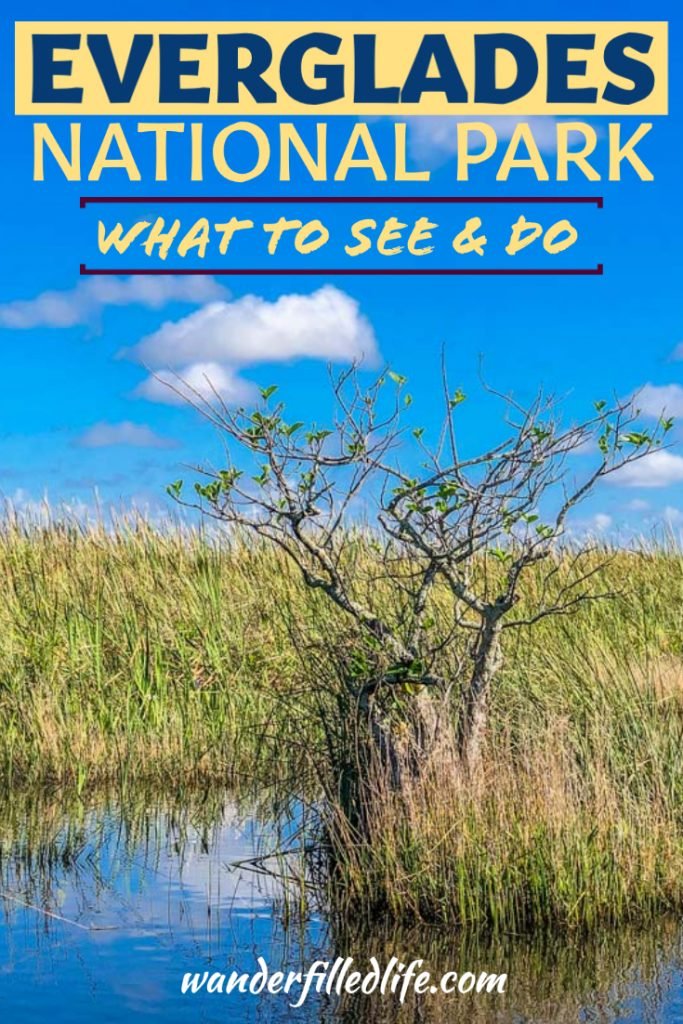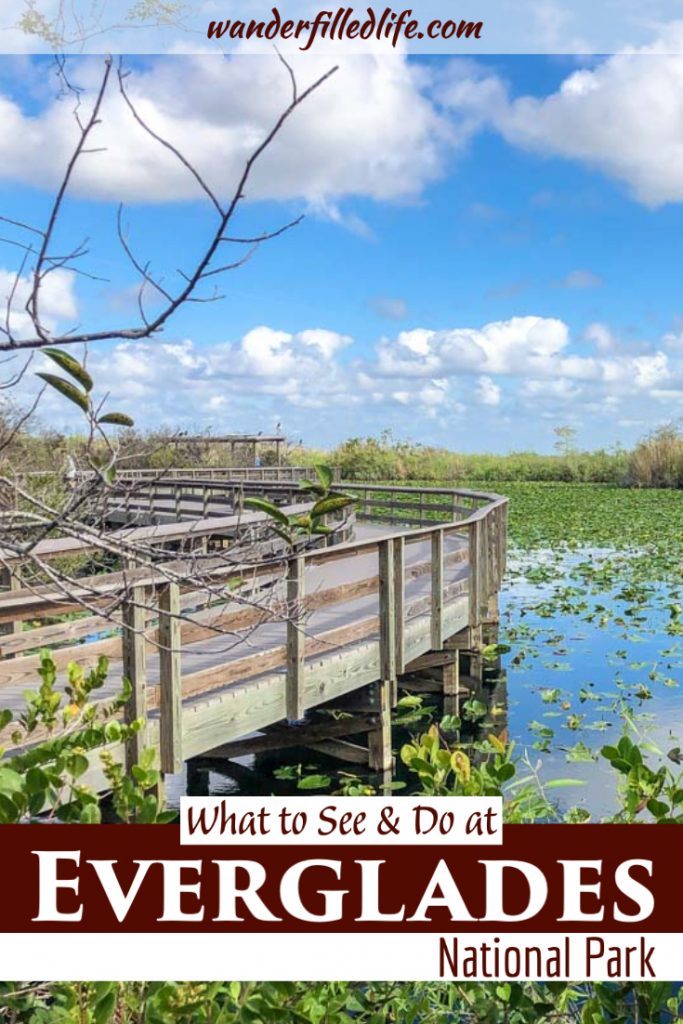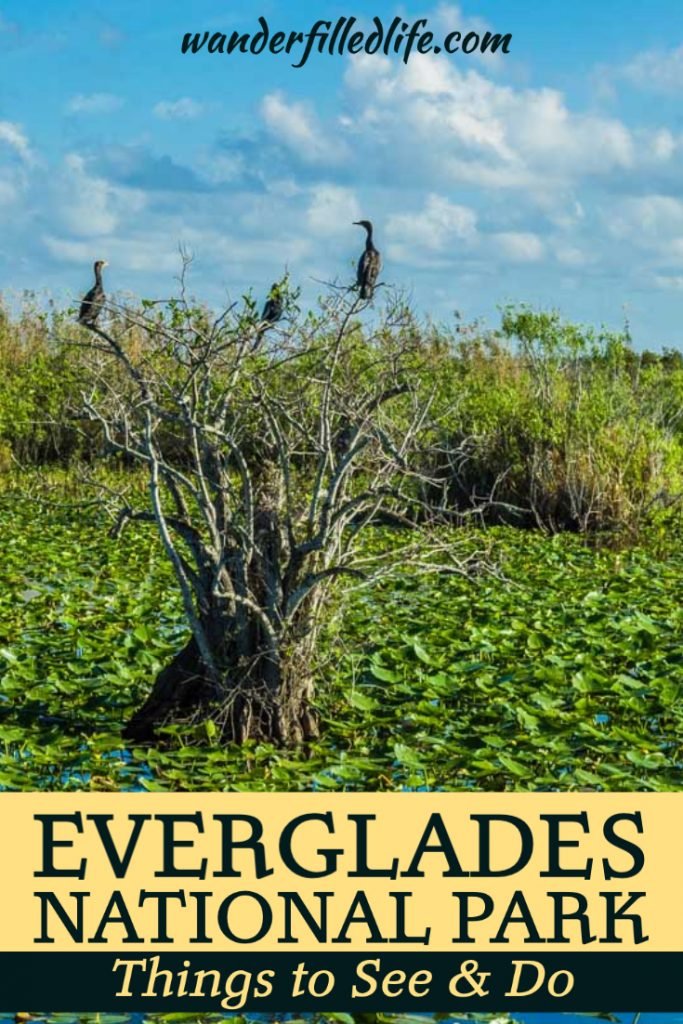Last Updated on May 30, 2023 by Grant
When you first arrive, the Everglades seems like an endless sea of grass. But there is so much more to discover, like mangrove channels, tropical hardwoods and cypress holes and all of the varied wildlife that goes with the various ecosystems. In short, you will find a ton of things to do in the Everglades and Big Cypress.
We spent three days exploring the two similar, yet very different units of the National Park Service. We never ran out of things to do in the Everglades National Park and Big Cypress National Preserve. Indeed, there’s a lot we didn’t have time for and we want to come back for a third visit!
Looking for more parks in South Florida? Check out our Guide to the South Florida National Parks.
Visiting Everglades National Park
As usual, our first piece of advice when visiting a national park is to stop at the visitor center. The rangers at the visitor center are able to give you far more up-to-date information than any guidebook or blog (us included!) can.
The Ernest F. Coe Visitor Center should be your first stop on the way into the main entrance to the park. There is plenty of good information on what is available for when you visit, based upon the season.
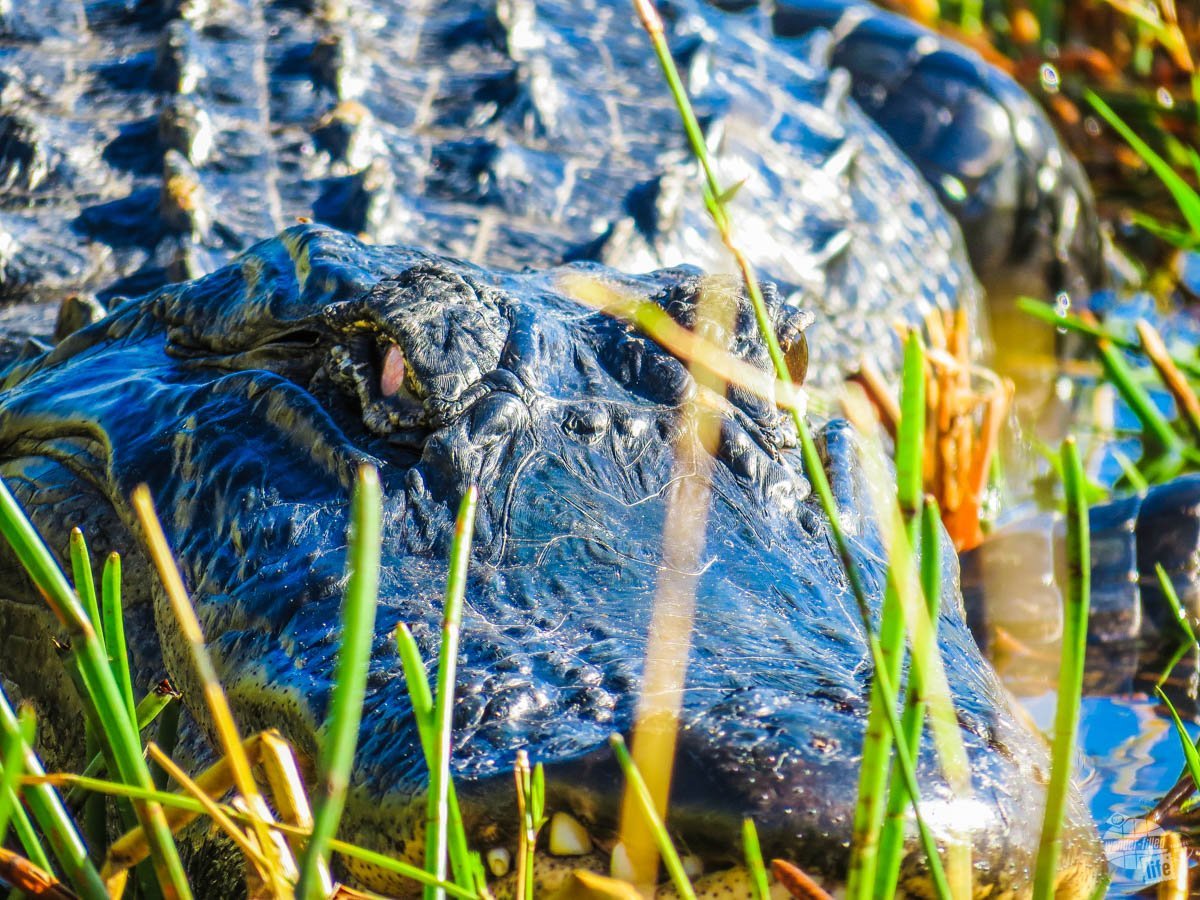
Pro tip: The Everglades has two seasons: Rainy and Dry. The rainy season runs from mid-May through November. The dry season runs from December through April.
After that, head immediately to the Royal Palm Visitor Center (which is quite small) for the Anhinga and Gumbo Limbo trails.
Things to Do in the Everglades: Walk the Anhinga and Gumbo Limbo Trails
If you see nothing else in the Everglades, walk the Anhinga Trail. This 0.8-mile trail and boardwalk will take you around a large pond teeming with wildlife. You will spot tons of birds, fish, turtles and alligators.
We highly recommend getting here early in the morning. Wildlife is always more active before the heat of the day.
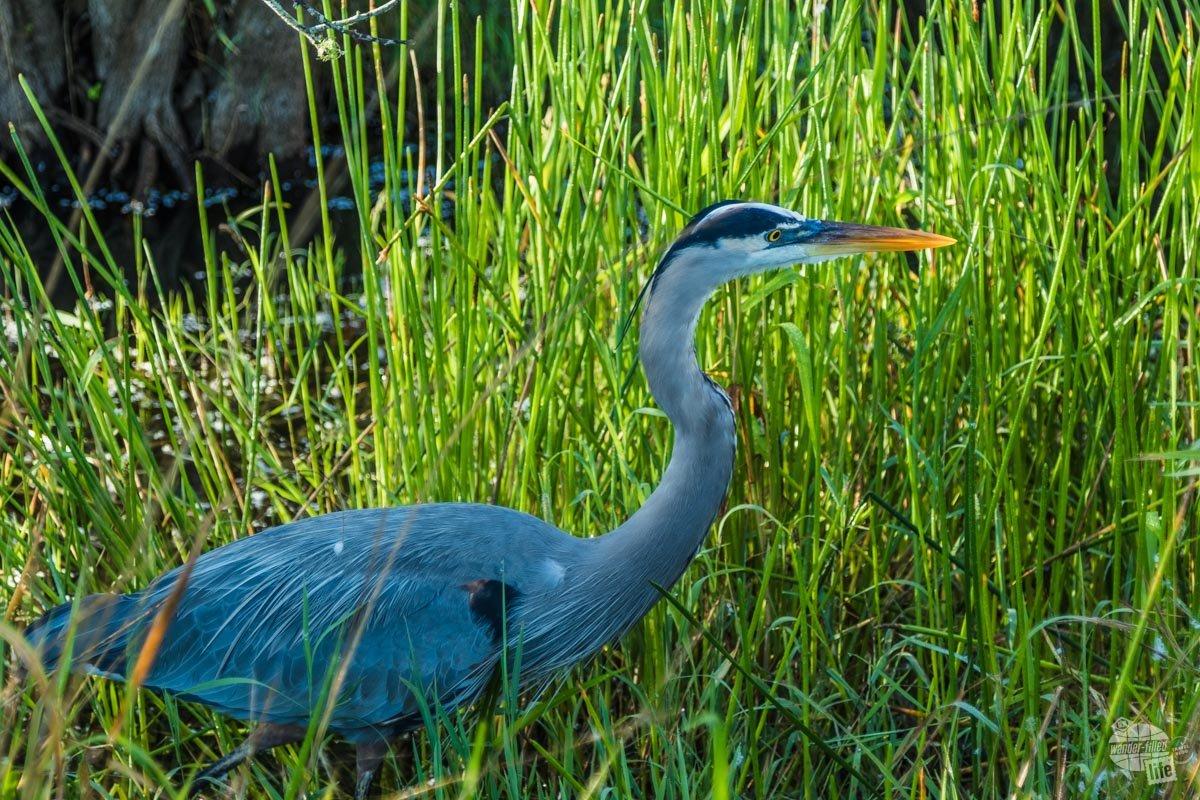
Pro tip: Polarized sunglasses will help you spot wildlife underwater.
The trail is completely flat and wheelchair accessible. While it is short, expect to spend an hour at least watching the various wildlife. I particularly enjoy watching the anhinga birds chase down their prey. These birds swim underwater and spear fish with a needle-nosed beak. Then they take the fish to the shore, flip it up off their beak and catch it in their mouths.
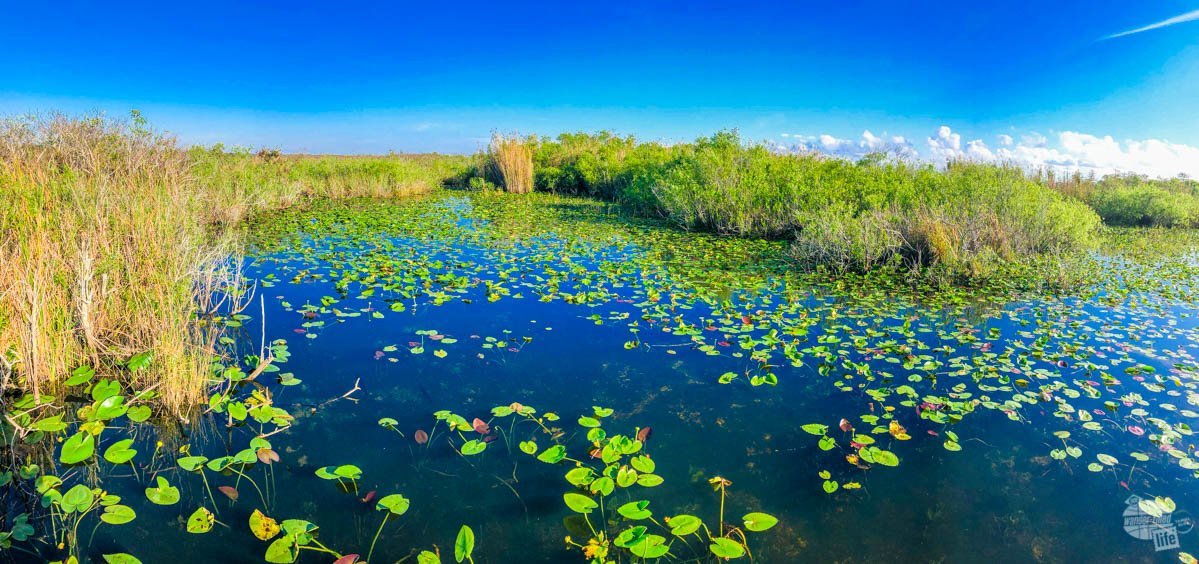
As the dry season goes on, the water levels drop in the pond and the gators become a lot more visible. You will likely spot a gator regardless of the season. Truly, there are alligators everywhere in the Everglades.
Hiking the Gumbo Limbo Trail
After spending some time at the Anhinga Trail, take a brief stroll through the Gumbo Limbo Trail. The contrast between the pond and this Tropical Hardwood Hammock is stark.
Hammocks are small islands of higher ground found throughout the Everglades. This hike provides a brief look into one of these hammocks and is labeled to let you know what tree is what.
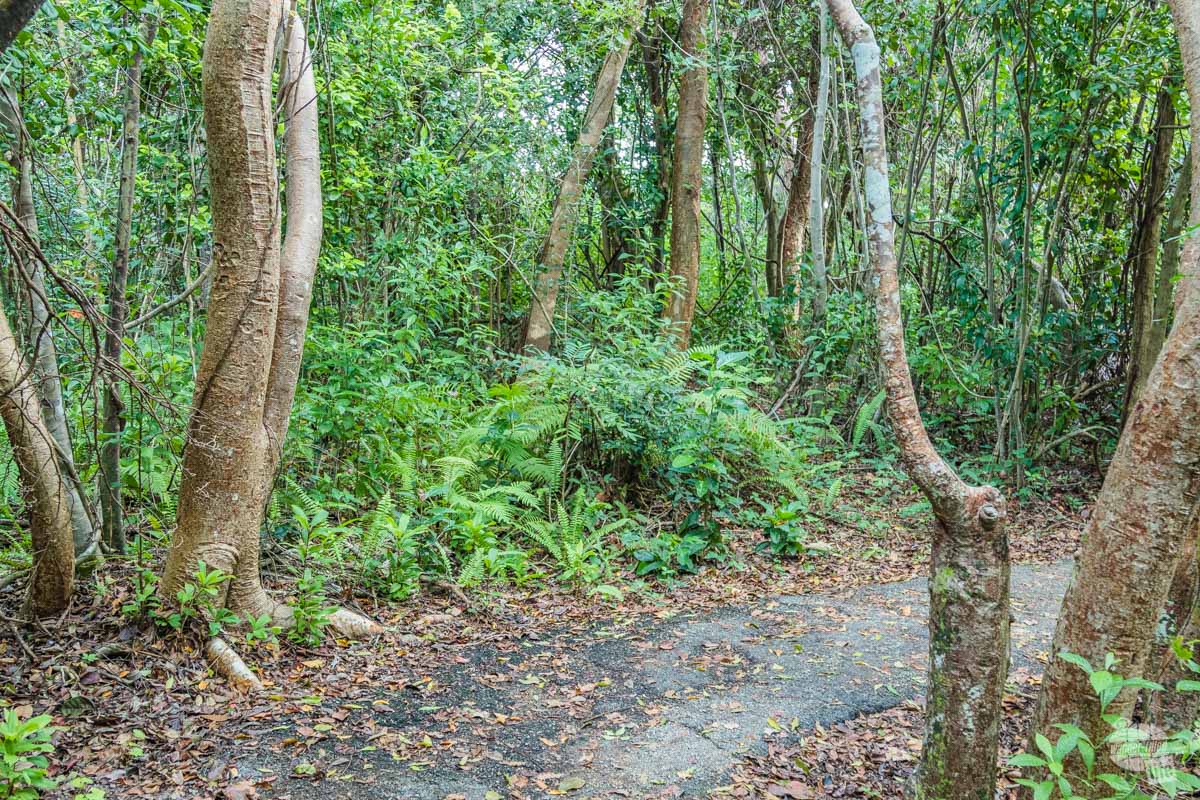
Be sure to keep an eye out for tree snails! In the dry season, these snails climb up trees. They affix themselves to the trunks and hibernate until the wet season. We found several on this trail, the Pinelands Trail and the aptly-named Tree Snail Hammock Trail in Big Cypress NP.
This loop trail is a bit brief (0.4 miles) but it provides a respite from the sun. The contrasts between the more open river of grass nearby is staggering.
Pro tip: Make sure you use a tarp to cover your car with a tarp when you get to the Royal Palm Visitor Center. On our first visit, there was a swarm of vultures that would rip out the black rubber weather stripping and windshield wipers.
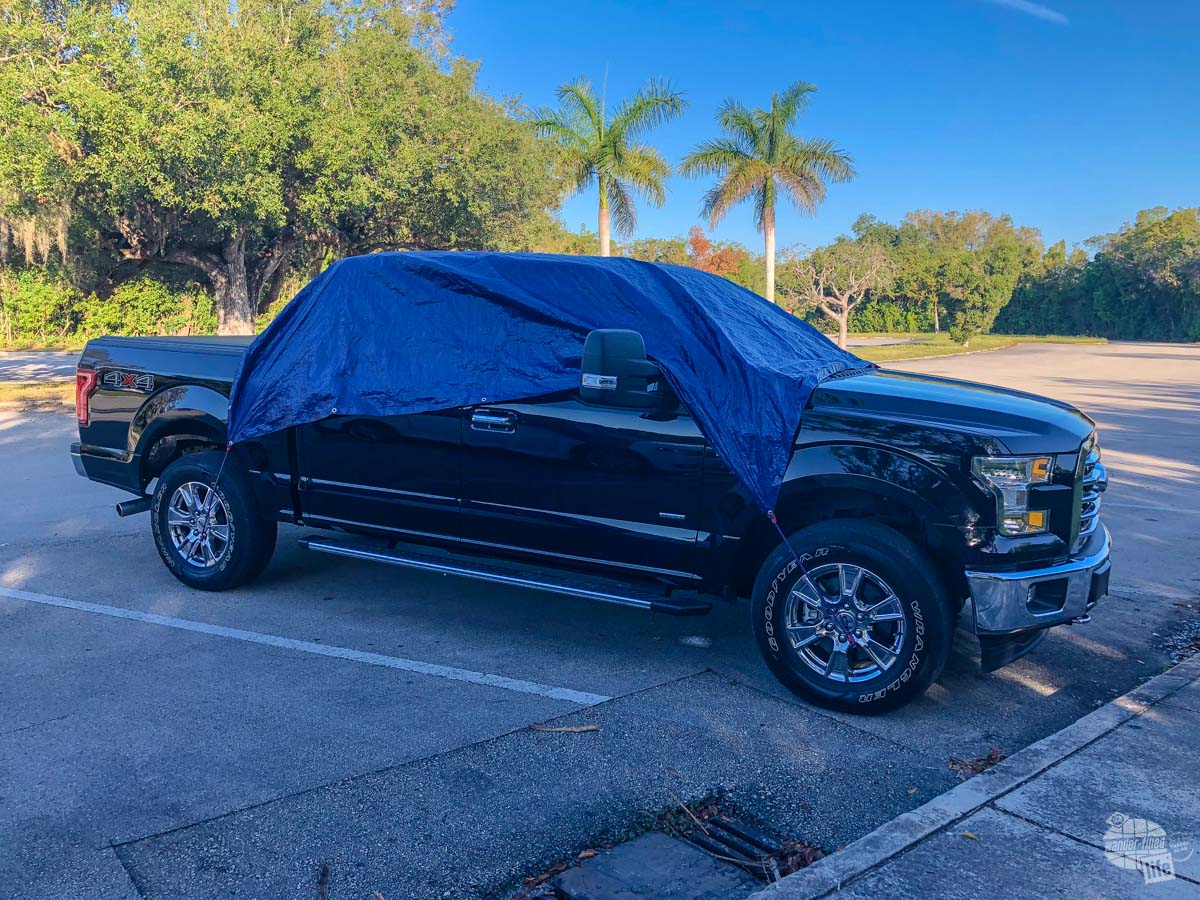
Things to Do in the Everglades: Check out the Nike Missile Site
One of the more odd things to do in the Everglades is to visit a Cold War-era missile site.
Yes, you read that right. There is a decommissioned Army anti-aircraft missile battery left over from the Cuban Missile Crisis located in the middle of Everglades National Park.
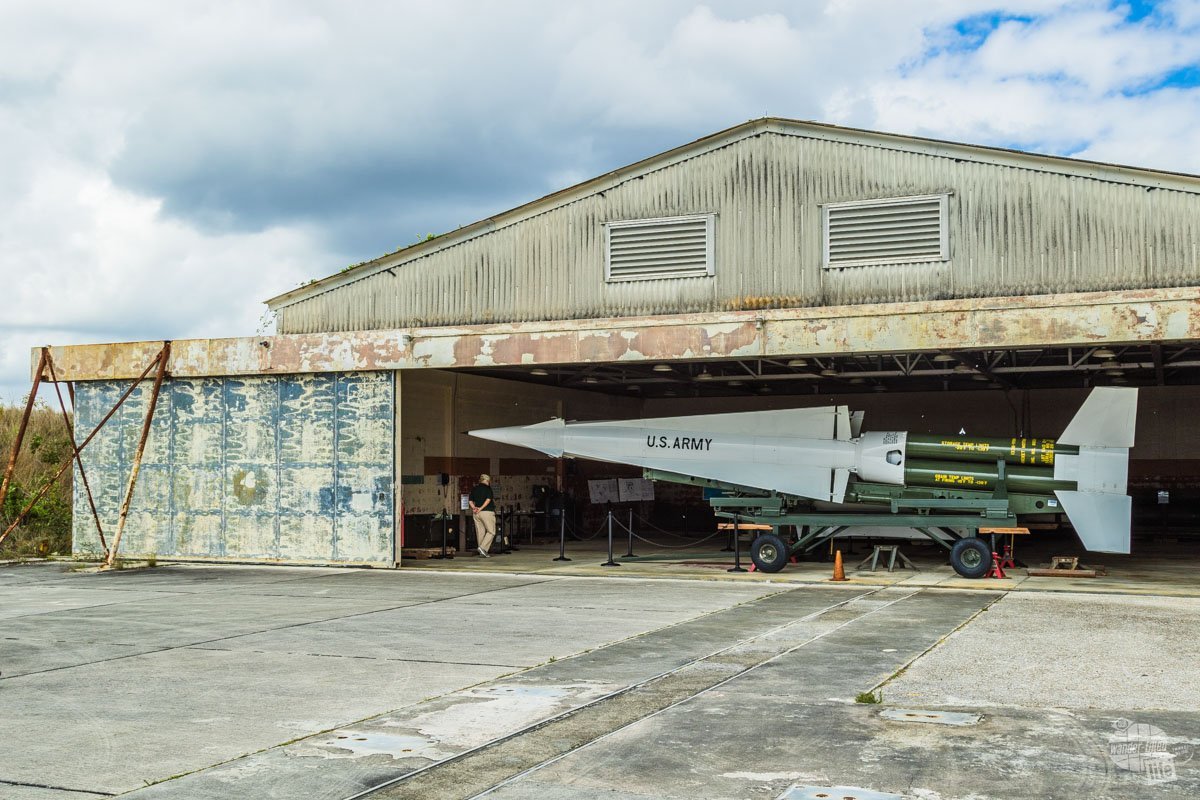
Originally, the land was part of a farm that defaulted on federal loans. When the land was folded into the Park, the Army wanted a piece for an air defense site. So, the missiles were never technically located in the park. Once the Army was done with the land, it reverted to the Park Service.
The site was operational until 1979 and housed a battery of missiles that could be armed with nuclear warheads to stop large groups of incoming bombers. Visiting the site requires driving out during open house hours. Be sure to check with rangers at the visitor center to determine when the site is open.
Pinelands Trail, Mahogany Hammock and Pa-hay-okee Overlook
Located on Park Road, these three trails allow you to see three of the different habitats within the Everglades: the pinelands, a hardwood hammock and a great view of the river of grass of the Shark River Slough (pronounced “slew”).
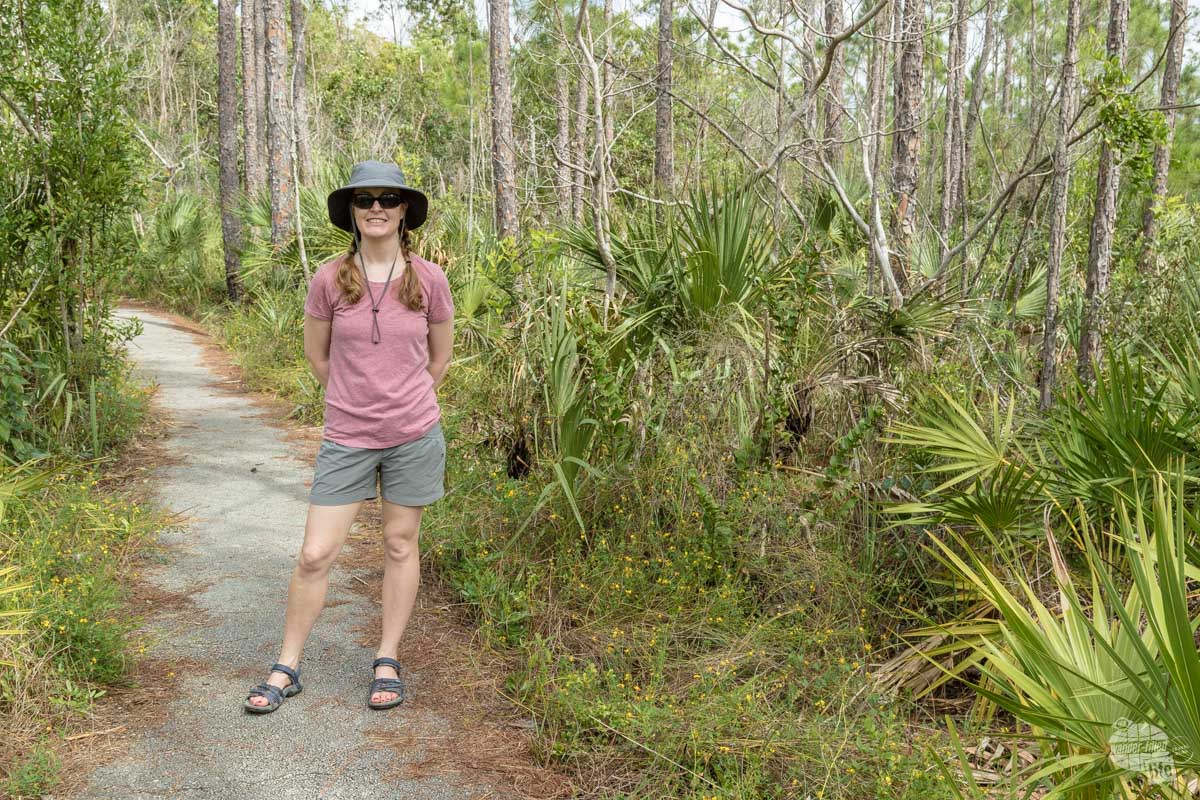
The Pinelands Trail is less than half a mile and takes you through a dry pinelands area that borders a hardwood hammock. You can see as you walk along the trail the difference in these two kinds of forest within the park.
The Mahogany Hammock Trail is about the same length and tours a hardwood hammock, much like the Gumbo Limbo Trail. If you are short on time, you can skip this trail if you have already been to either the Gumbo Limbo Trail or the Tree Snail Hammock Trail. Still, it’s a pretty trail and worth the time. Back in 2012, we even spotted a barred owl in the nook of one of the trees on this trail.
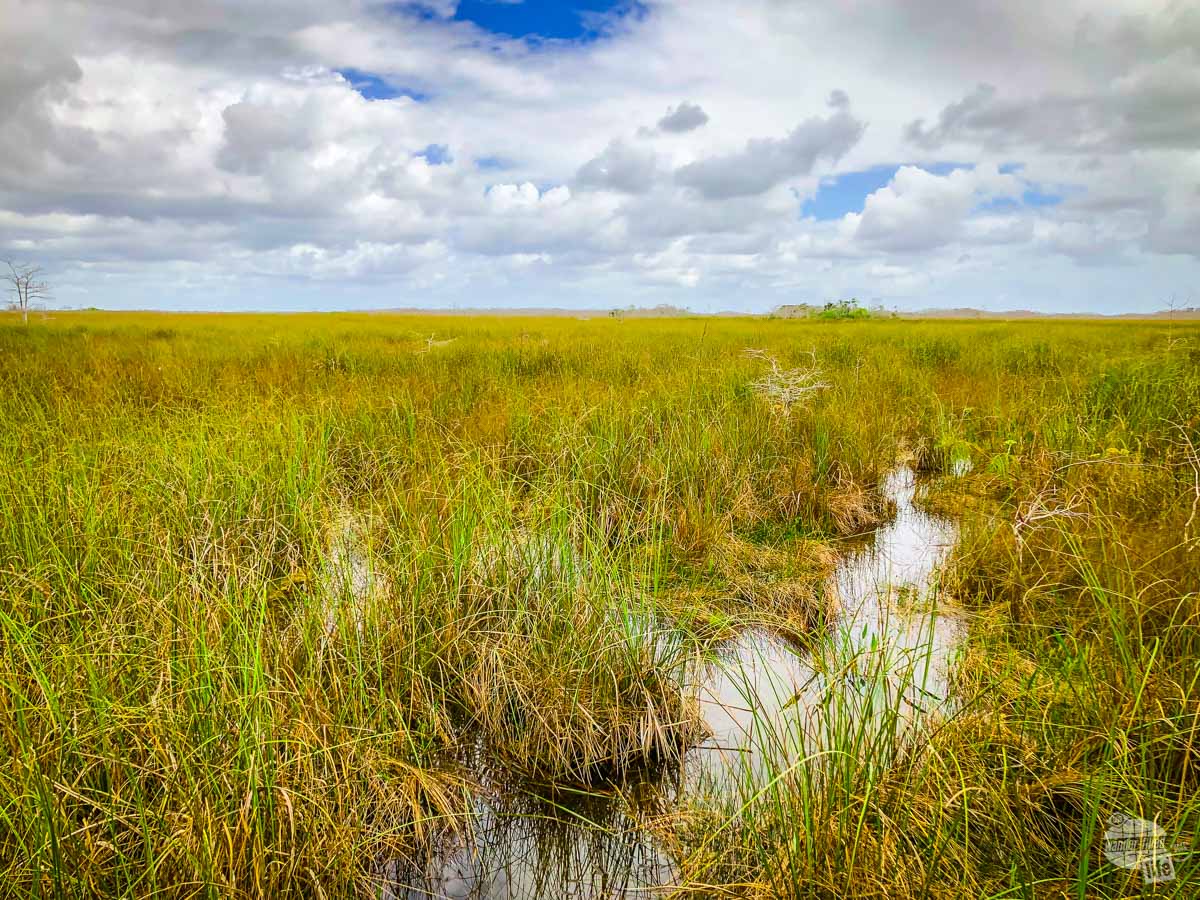
The Pa-hay-okee Overlook is the shortest of these brief walks and leads to an elevated overlook which gives you views of the “river of grass” which flows through the Everglades. It is also surrounded by cypress and hardwoods, making it a good way to see both habitats.
Things to Do in the Everglades: Paddle Nine Mile Pond
One of the absolute coolest things to do in the Everglades is getting out on the water in a canoe. We signed up for a ranger-led tour of the Nine Mile Pond Canoe Trail.
In order to sign up for this free tour, you need to call the Flamingo Visitor Center. This took several calls to get through to the folks at Flamingo. Once we did get through, they did their best to dissuade us.
“This tour is tough, you have to paddle, there is no way to go back once you get out there and there is no bathroom.”
It also involved getting up pretty early to make our 7:30 a.m. departure since we were camped about an hour from the park.
Honestly, this turned out to be the best thing we did the entire time we were in the Everglades.
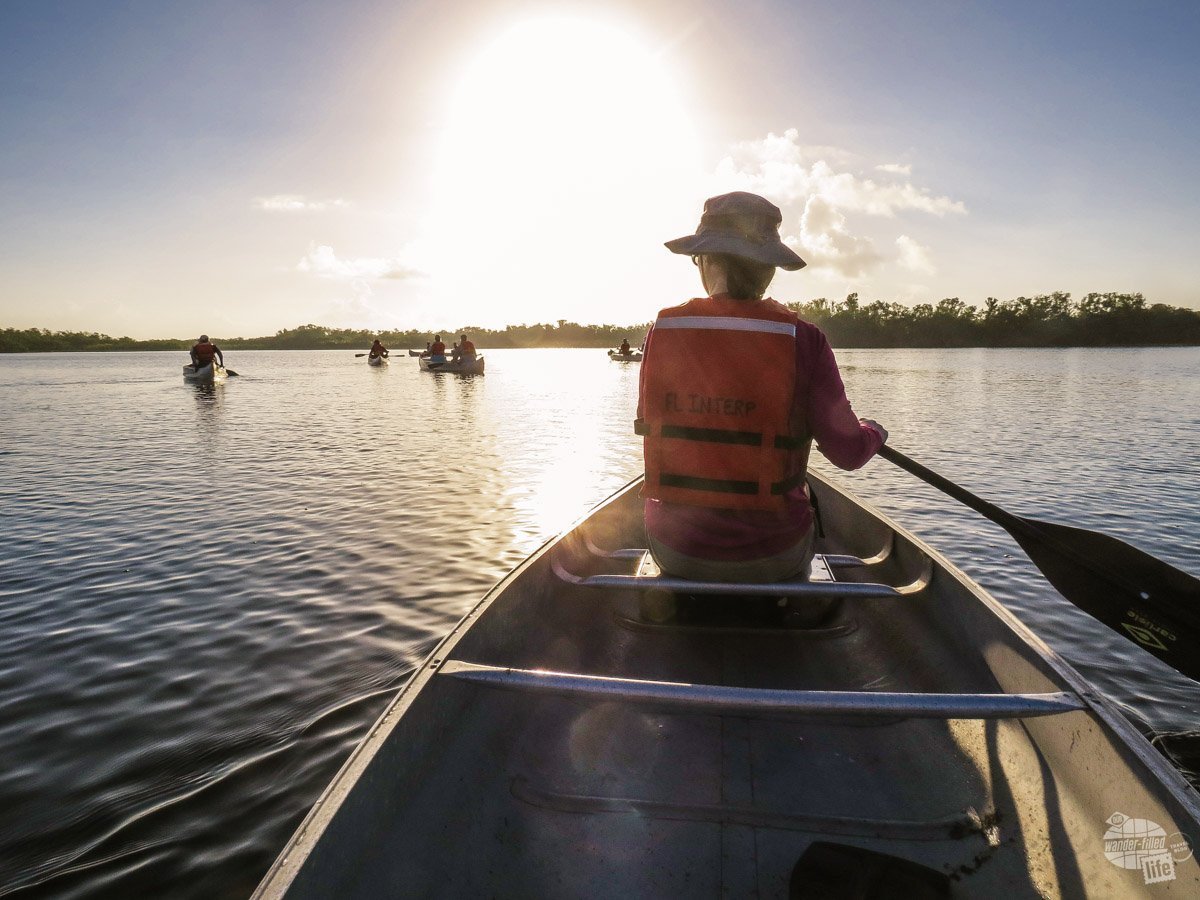
We started out on a large pond and the ranger gave folks time to get used to canoeing. We have both canoed before but never with each other, so we were glad to have some time to get used to paddling the canoe before we got into some of the tighter channels.
Almost immediately, a large gator swam by us in the pond. It was just cruising to the other end and was not bothered by us but it definitely bothered some of the other folks on the tour.
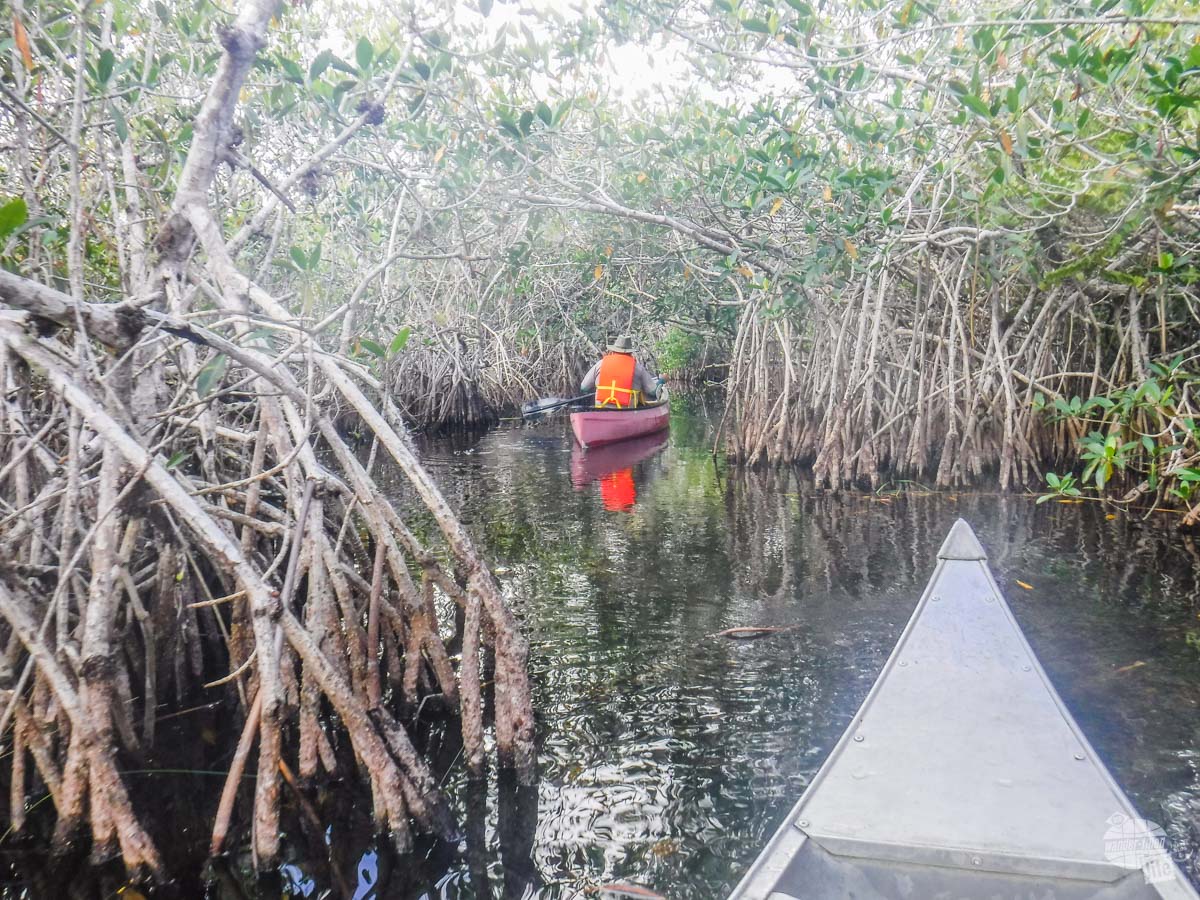
After crossing the first open area, we started navigating through mangrove channels. That is where knowing how to paddle came in handy and quickly. Bonnie and I briskly handled the tight spots with minimal fuss. I can’t say the same for the couple behind us.
“No! Paddle the other way! The OTHER WAY!”
The interesting thing about the mangroves is there is no saltwater here. These plants were blown in by a hurricane, at least according to the ranger giving the tour. While paddling through the mangroves, be on the lookout for birds, air plants and, of course, gators. We heard one growl and hiss at us from the mangroves but never actually saw it.
Pro tip: you can paddle this trail yourself, so bring a canoe or kayak if you have one. You can rent canoes kayaks from the Flamingo Marina Store. The trail markers are sometimes difficult to see, though, so be sure to talk to a ranger before heading out on this canoe trail on your own.
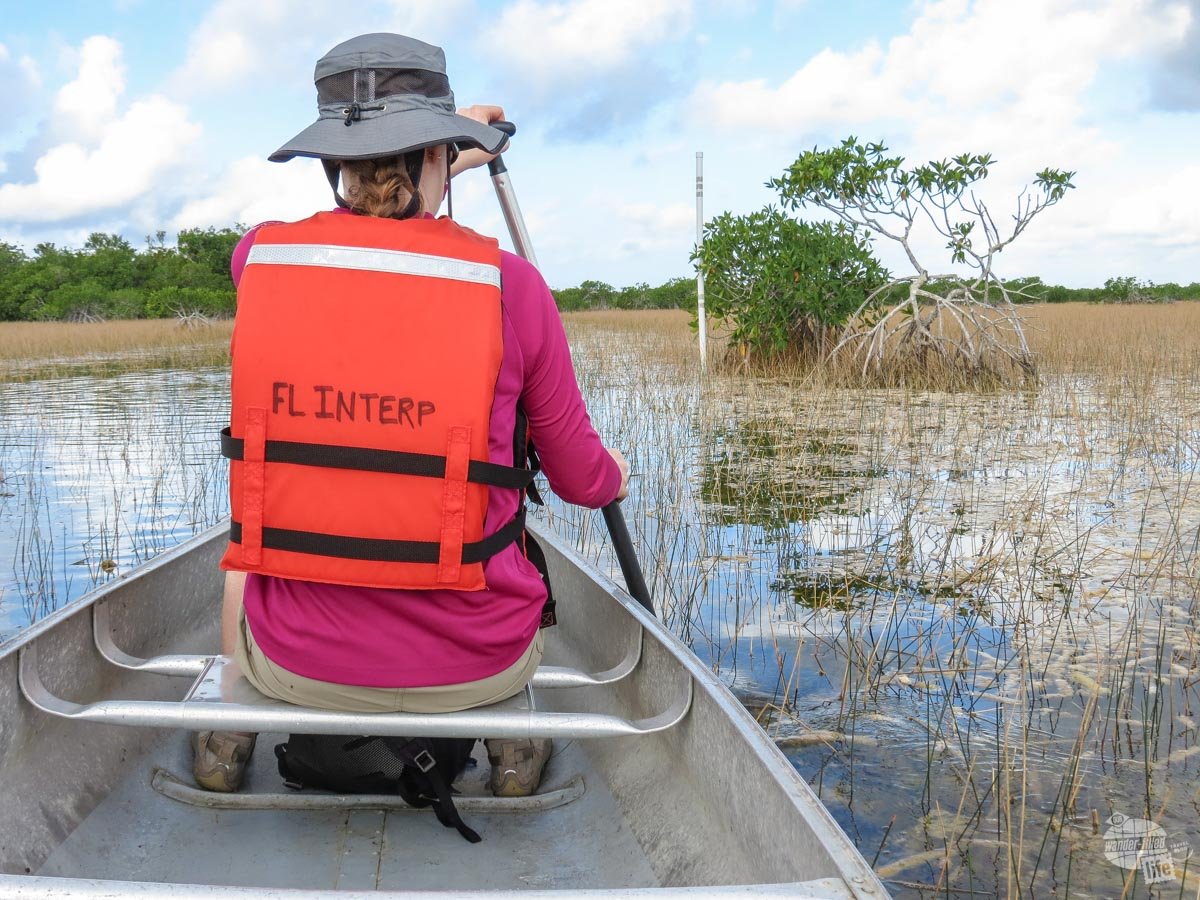
The trail is marked with white PVC pipes but even with a ranger guide, there were a couple of spots where we took a wrong turn and ended up having to backtrack a bit. You really have to pay attention to the trail and, honestly, that can be a bit hard. It’s so pretty and so quiet. It’s hard to keep your eyes on the trail when you are looking at all the beauty around you.
We stopped at about the halfway point to eat a snack and while we were waiting, we could see a large gator up ahead of us. Then the gator stuck its head and tail out of the water, arching its back and bellowed! Honestly, we had no idea how big this gator was until he did that. It was huge!
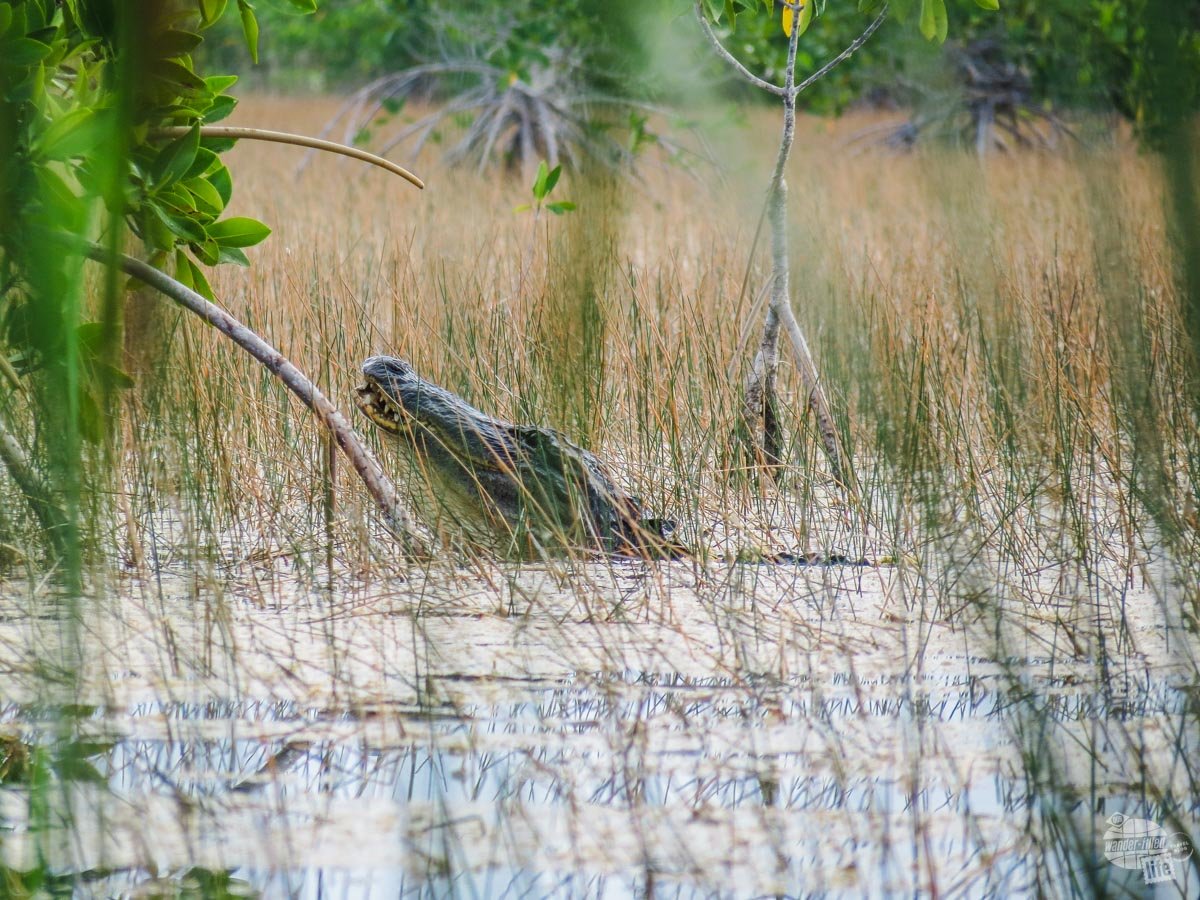
Gators bellow to mark their territory and to attract a mate. While this guy was not terribly close to us, it was still a bit disconcerting! It is one thing to see a gator from above on a boardwalk. It is another thing to see one from an airboat (more on that below). Seeing one in a canoe, especially a big bull alligator bellowing… That’s a whole different ballgame!
He moved away from us in a different direction than our travel but we still gave where he was a wide berth. We paddled on through the rushes, a grassy area.
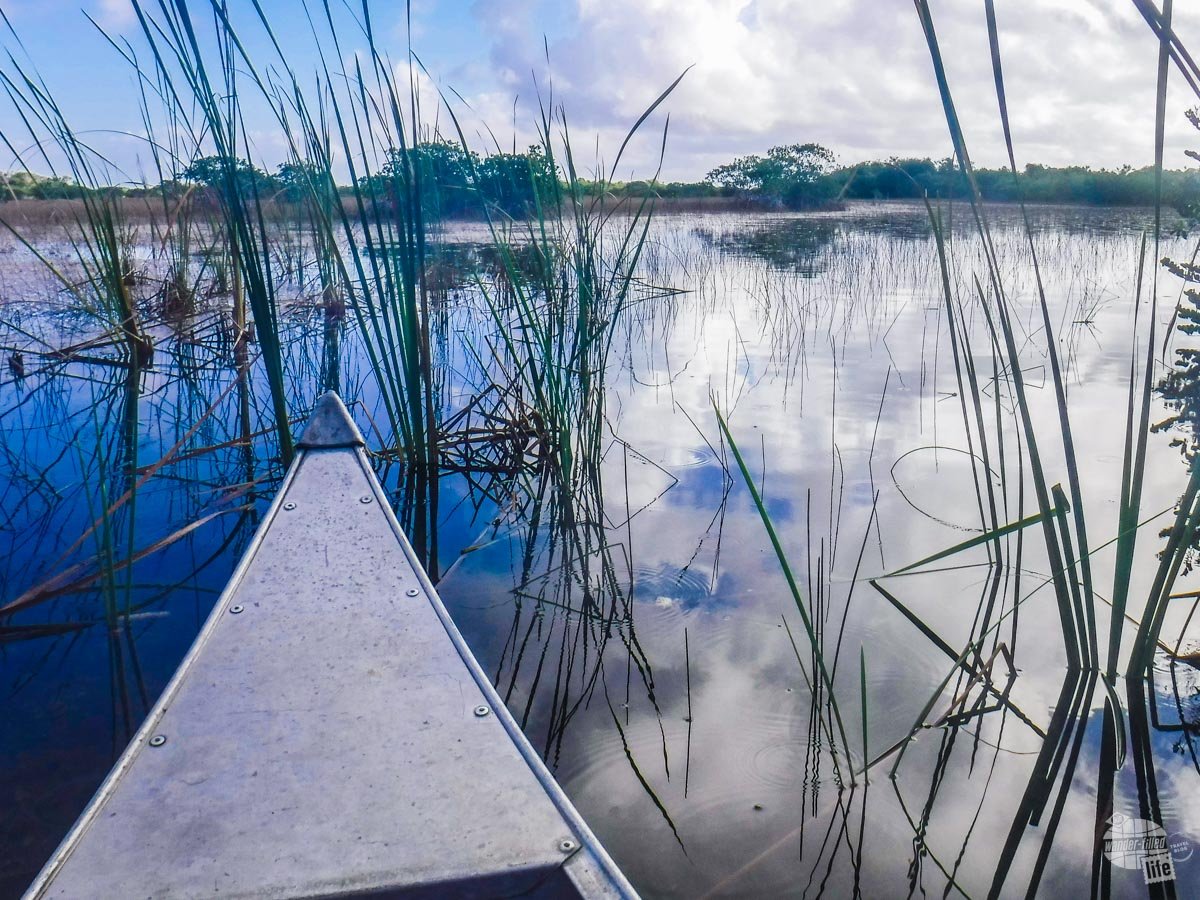
One thing to note about paddling this trail in the dry season: if the water level drops too much, there are parts of the canoe trail that are impassable by boat.
As we paddled on, we ended up passing through another section of mangrove channels. We turned a bend and the ranger quickly stopped us. A gator was hanging out in the channel. We made a bit of racket banging our paddles against our canoes and the gator kindly moved to the side, allowing us to pass without having to turn around.
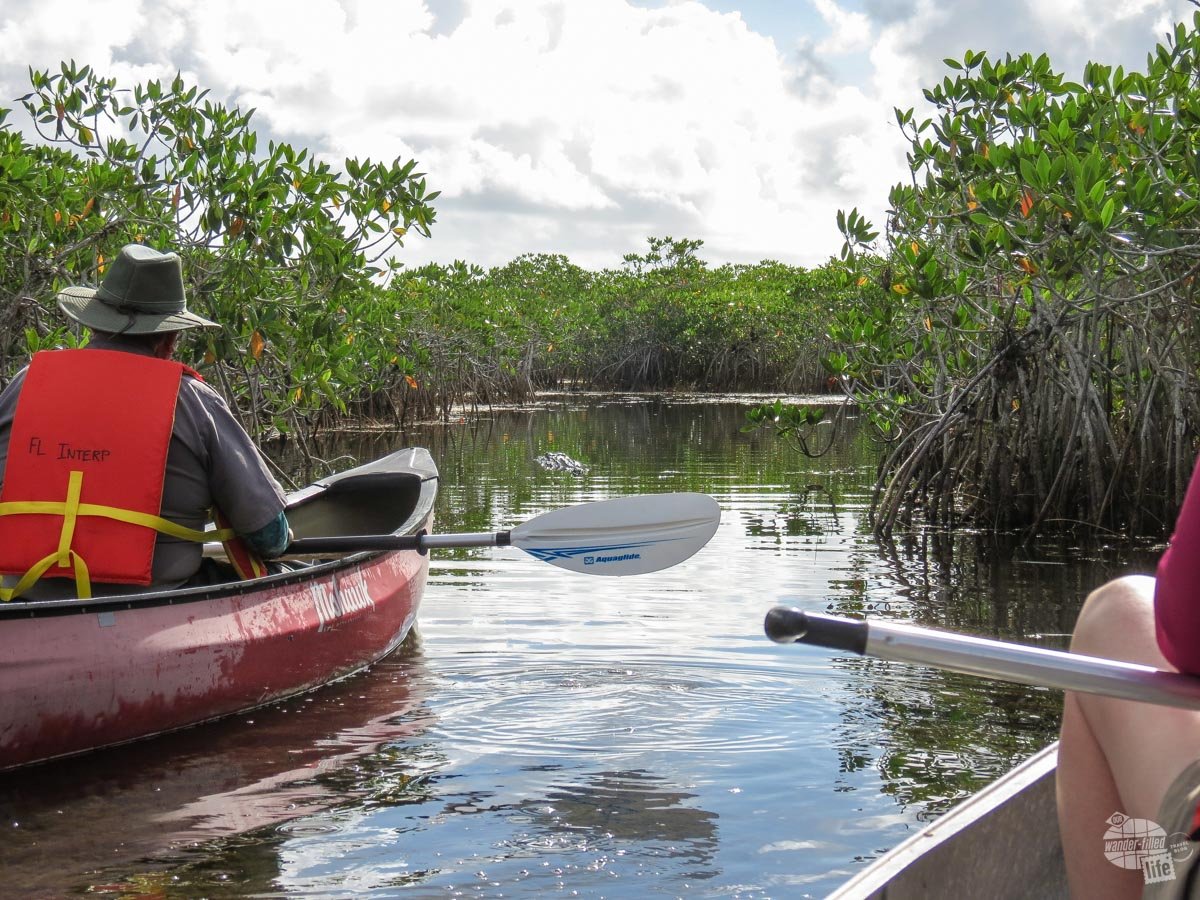
As the tour ended, we found ourselves in a pond at the end. This pond is the home of Croczilla, a 13-foot American crocodile. We saw his favorite spot on the banks of this pond but alas, no Croczilla. The Everglades are the only place where crocodiles and alligators coexist.
In all, paddling Nine Mile Pond has to be one of the best ranger-led tours we have ever done and we can’t recommend it enough.
Flamingo Visitor Center
If you are looking to get out into Florida Bay on a boat, Flamingo Visitor Center and the marina there are where you want to be. There is also a campground, including rentable safari-style tents with normal beds in them at $150 per night. There is no lodge in the Everglades anymore due to being destroyed often by hurricanes. Indeed, the visitor center is a temporary building. There is no timeline for rebuilding a permanent structure.
There are a couple of trails in the area, including the Coastal Prairie Trail but most hiking in the Everglades is wet hiking. You can even go slough slogging with a ranger.
Pro tip: If you are interested in getting out in the Everglades on foot, bring old hiking shoes that you are ok with getting incredibly muddy.
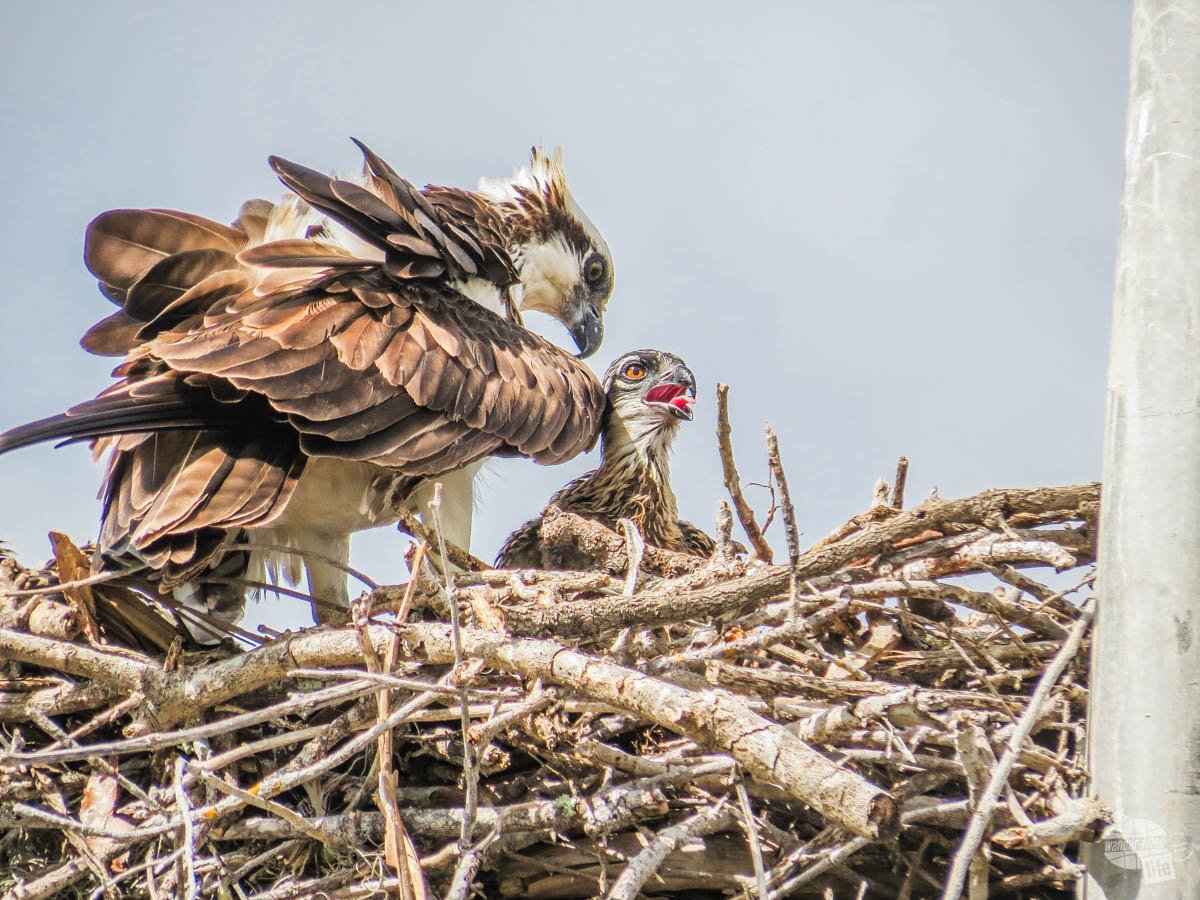
Be sure to stop by the marina at Flamingo. We spotted an osprey nesting right by the water, a couple of manatees in the water and a couple of crocodiles right across the waterway from the marina. There’s also the Eco Pond Trail, a loop near the campgrounds.
Things to Do in the Everglades: Airboat Tour
As I said above, the best way to experience the Everglades is by boat and taking an airboat tour is a great way to do that.
There are three companies that offer airboat tours in Everglades National Park and we chose the oldest, Coopertown Airboats. All three tour companies are on the Tamiami Trail, which is on the north end of the park.
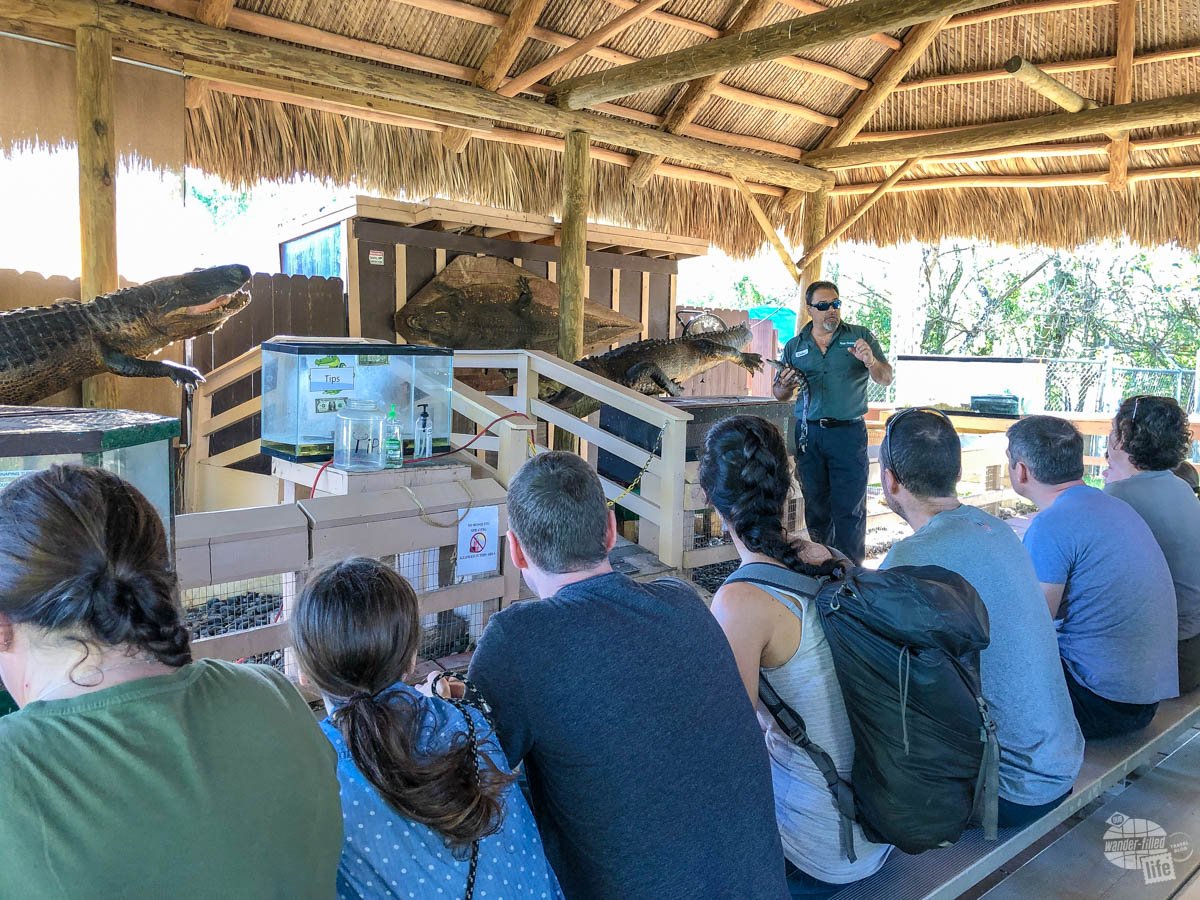
Our tour started off with a brief talk on the various reptiles found in the park, including several gators the company keeps on-site. From there, we got on the airboat, where we were given cotton balls to use as earplugs.
Pro tip: If you have your own earplugs, bring them. I had a couple in the truck and didn’t think about bringing them in. Also, don’t forget your America The Beautiful Pass. It will save you $3 per person on the tour.
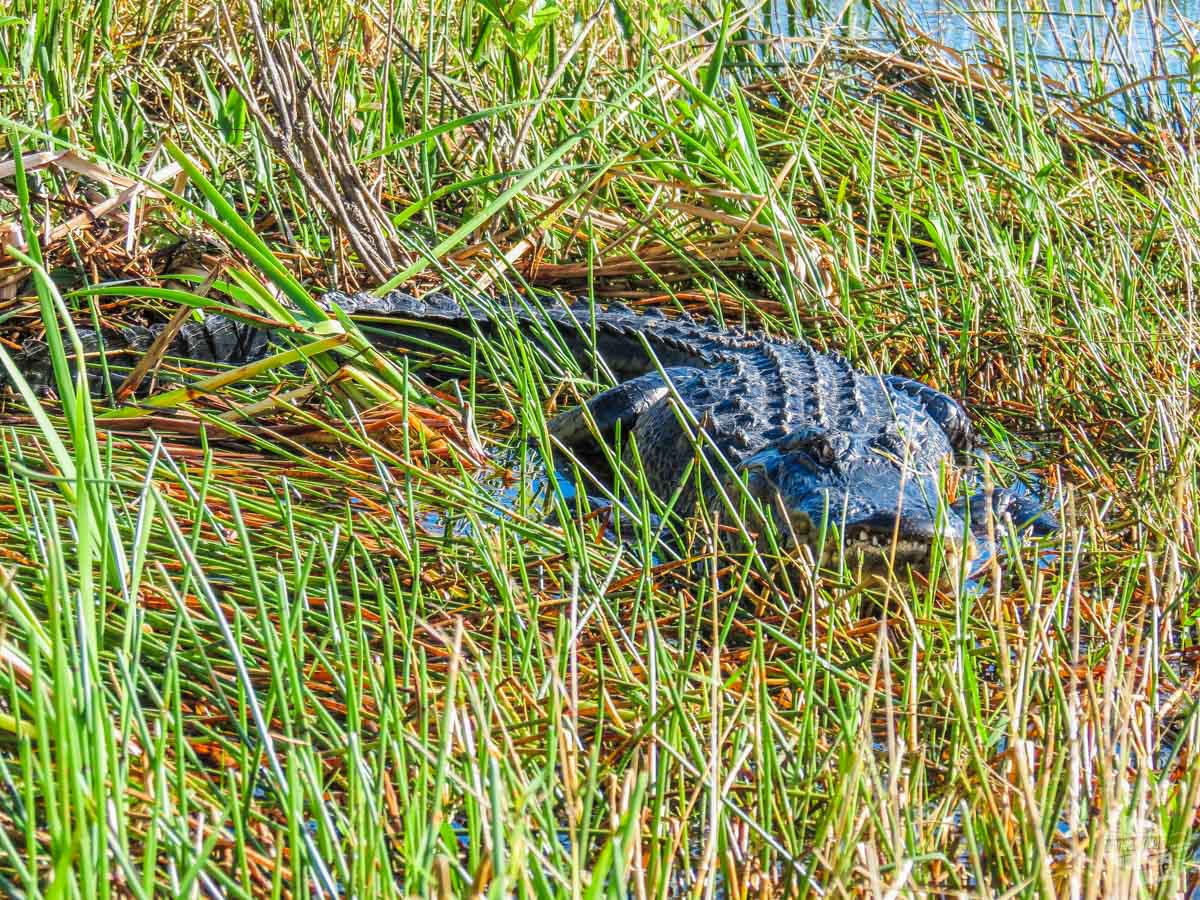
The tour takes about 45 minutes and takes you nine miles into the Everglades. The guides do a great job of explaining the nuances of the Shark River Slough and the wildlife found there.
You will see plenty of birds and, of course, gators. One of the things you learn really quickly is how to spot the males from the females: females only grow to about 5 feet long whereas males grow much larger.
In all, this is a classic Everglades experience and everyone should take an airboat tour at least once.
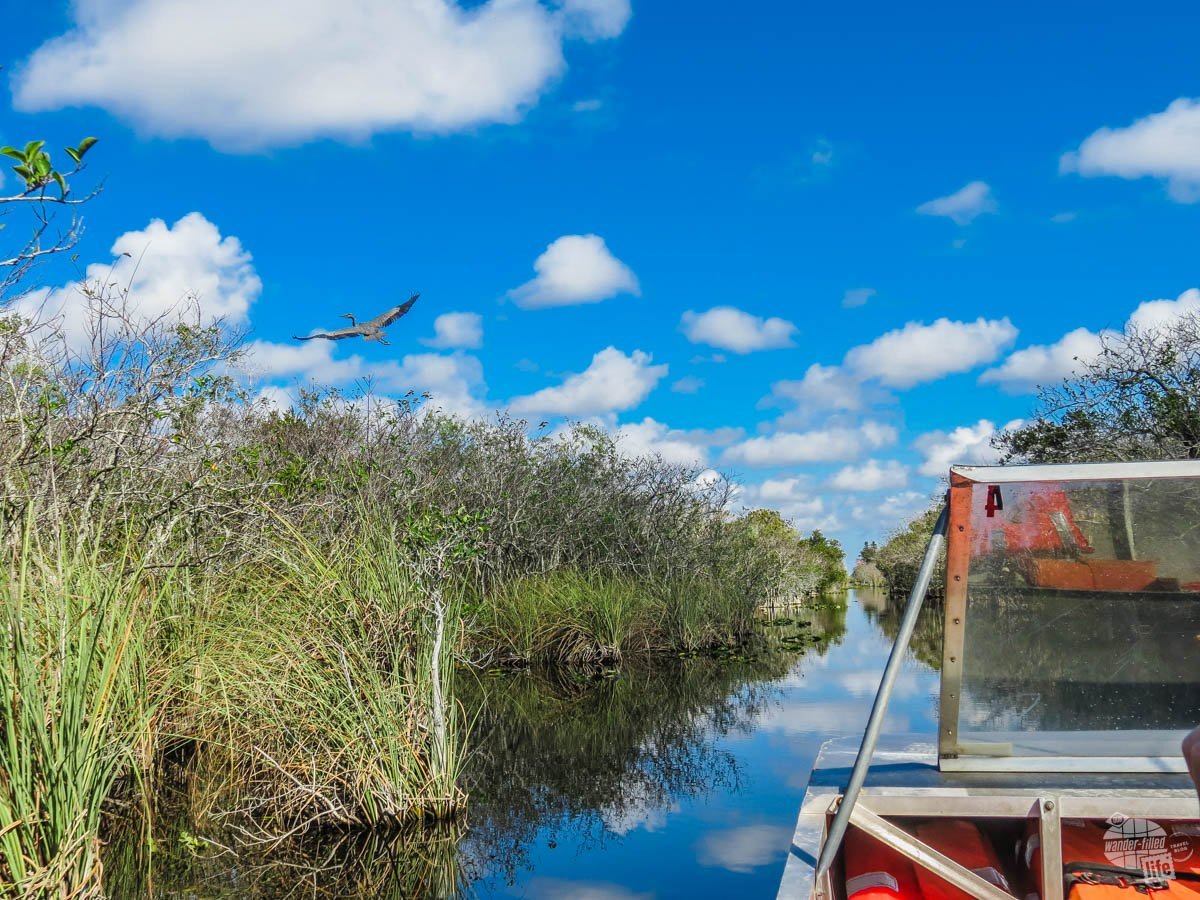
Shark Valley Visitor Center
Shark Valley offers a couple of cool things to do in the Everglades: a 15-mile biking/walking path or a two-hour tram tour.
We got there too late to rent a bike so we only walked a bit of the path and explored the Otter Cave Trail, which led through a hardwood hammock with several solution holes, which are small sinkholes in the limestone bed.
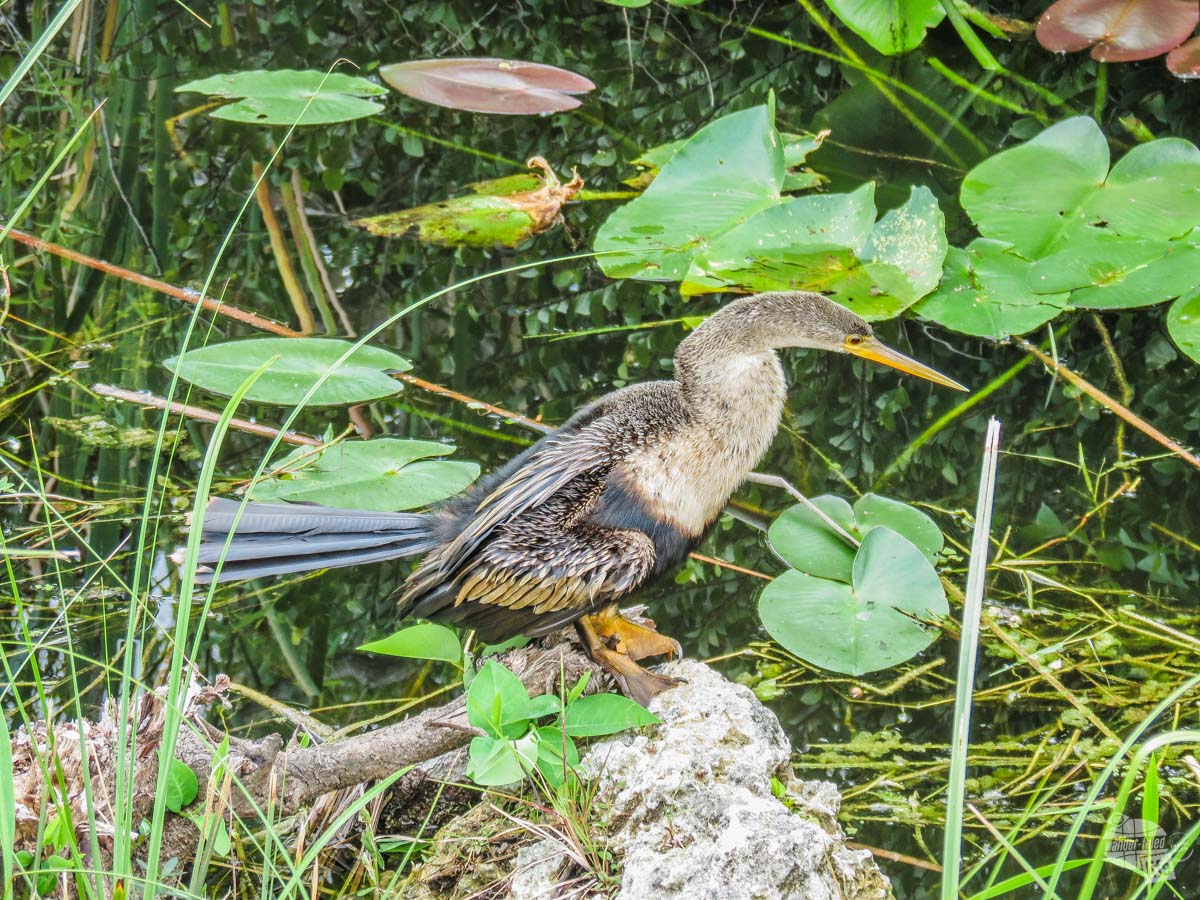
Bonnie and I have been thinking about getting some bikes to take with us when we travel and this spot really cemented that desire. We could have easily ridden our own bikes the length of the trail and been back by dusk.
It will have to wait for another trip.
Things to do in Big Cypress National Preserve
The first thing to understand about Big Cypress NP is that it is not a national park but rather a national preserve. That distinction is very important. While it sounds counterintuitive, a national preserve actually allows for various activities that you wouldn’t find in a national park, like hunting or driving a swamp buggy. You will also find inholdings, private land within the boundaries of the preserve, including tribal villages for the Miccosukee and Seminole.
Combined with the Everglades, several other state parks and the Florida Panther National Wildlife Refuge, Big Cypress NP preserves much of the flow of the water through this river of grass.
Throughout the preserve, you will find several large cypress swamps, which have deeper pools than found throughout most of the Everglades.
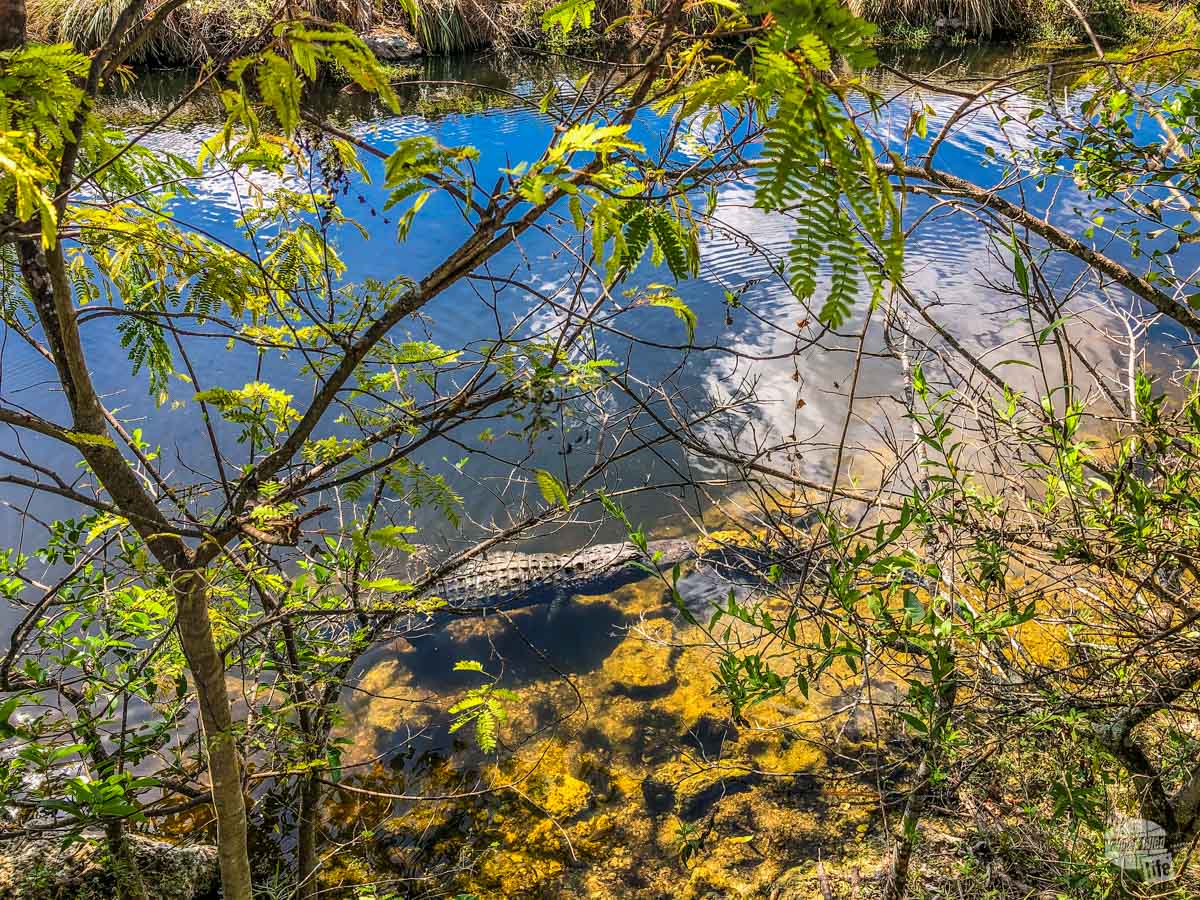
Your first stop should be either the Oasis Visitor Center or the Big Cypress Swamp Welcome Center. Both can give you an overview of the preserve and direct you to cool places to see.
In terms of touring the preserve, if you don’t own a swamp buggy or a canoe, your best bet is to drive a couple of the scenic loops through the preserve.
Big Cypress Scenic Drives
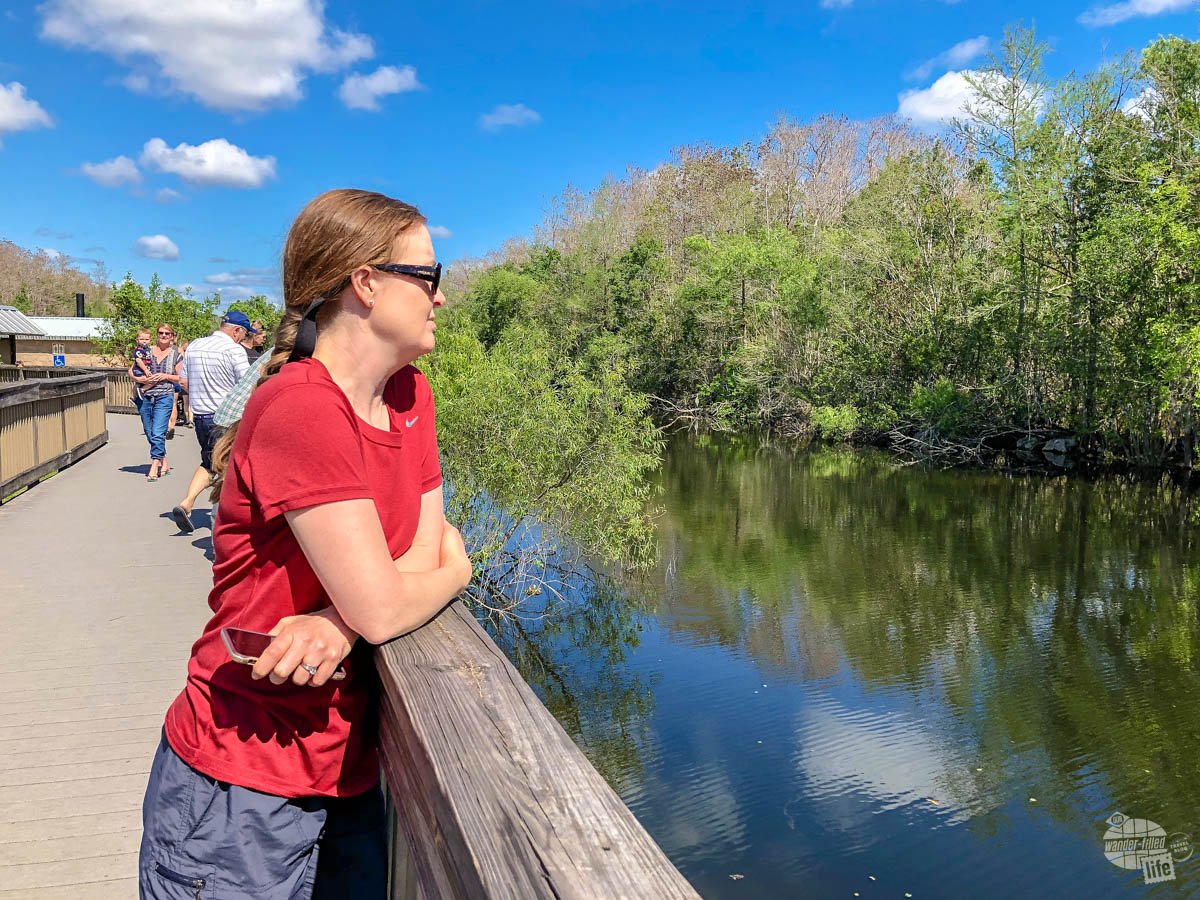
For our first drive, start at the H.P. Williams Roadside Park and then take Turner River Road north. Look on the right side for all sorts of wildlife. Once you hit Upper Wagonwheel Road, turn left and follow the road back to the Tamiami Trail.
This drive takes about 40 minutes. It is nice but if you only have time for one scenic drive, skip this one and head to the Loop Road. While this is pretty, the Loop Road is better.
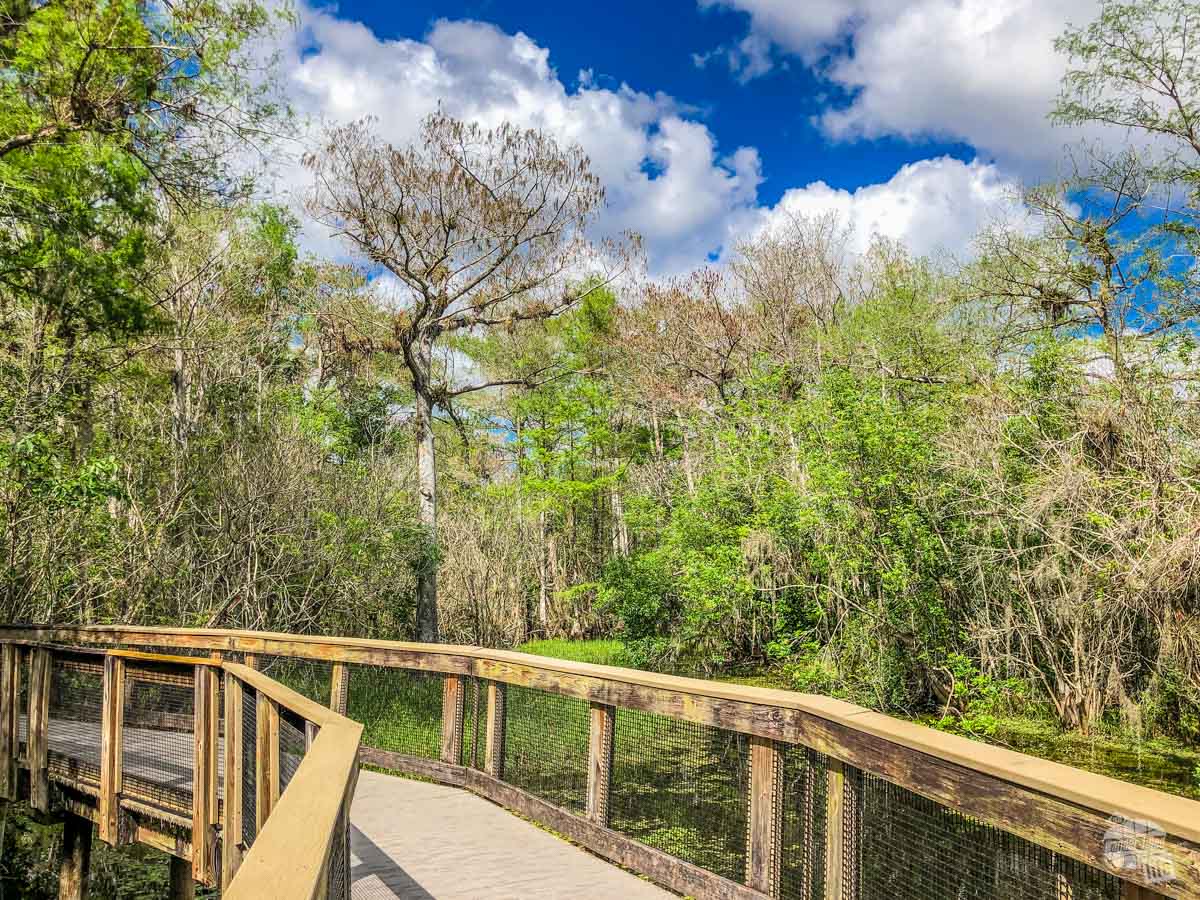
On the way to the Loop Road, look on the right south side of the Tamiami Trail for Kirby Storter Park. This park as an amazing boardwalk that will take you into a cypress swamp. At the end of the boardwalk, look for baby alligators in the pond below.
Keep heading east and look for Monroe Station and then turn south onto the Loop Road.
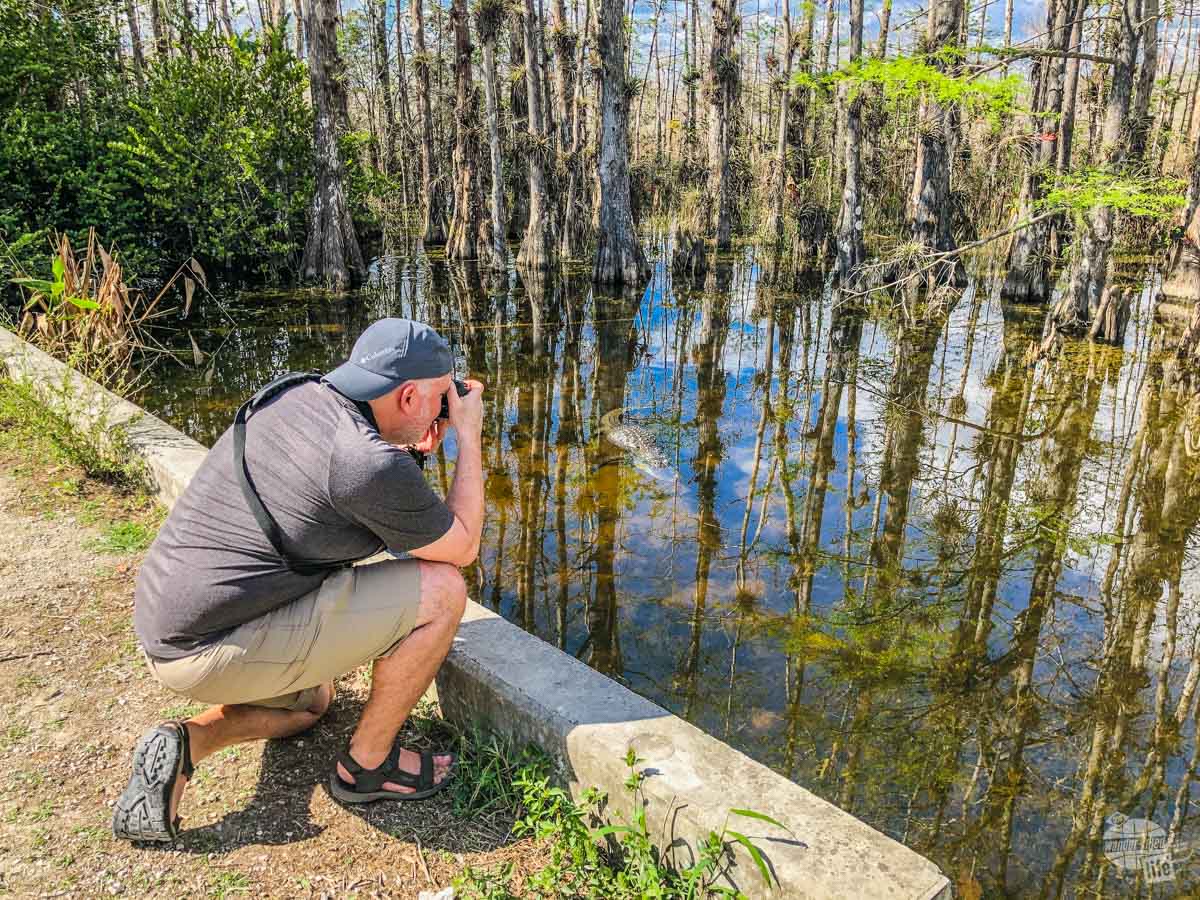
The Loop Road takes about 1.5 hours to dive and is best done on your way back to Miami since it ends at the far east end of the preserve. Indeed, if you are looking to visit Shark Valley in Everglades National Park, this road empties on to the Tamiami Trail just west of that turnoff.
The biggest thing I will say about this drive is to stop at the culverts. You will find tons of wildlife in the pools. We spotted lots of fish, birds and, of course, gators.
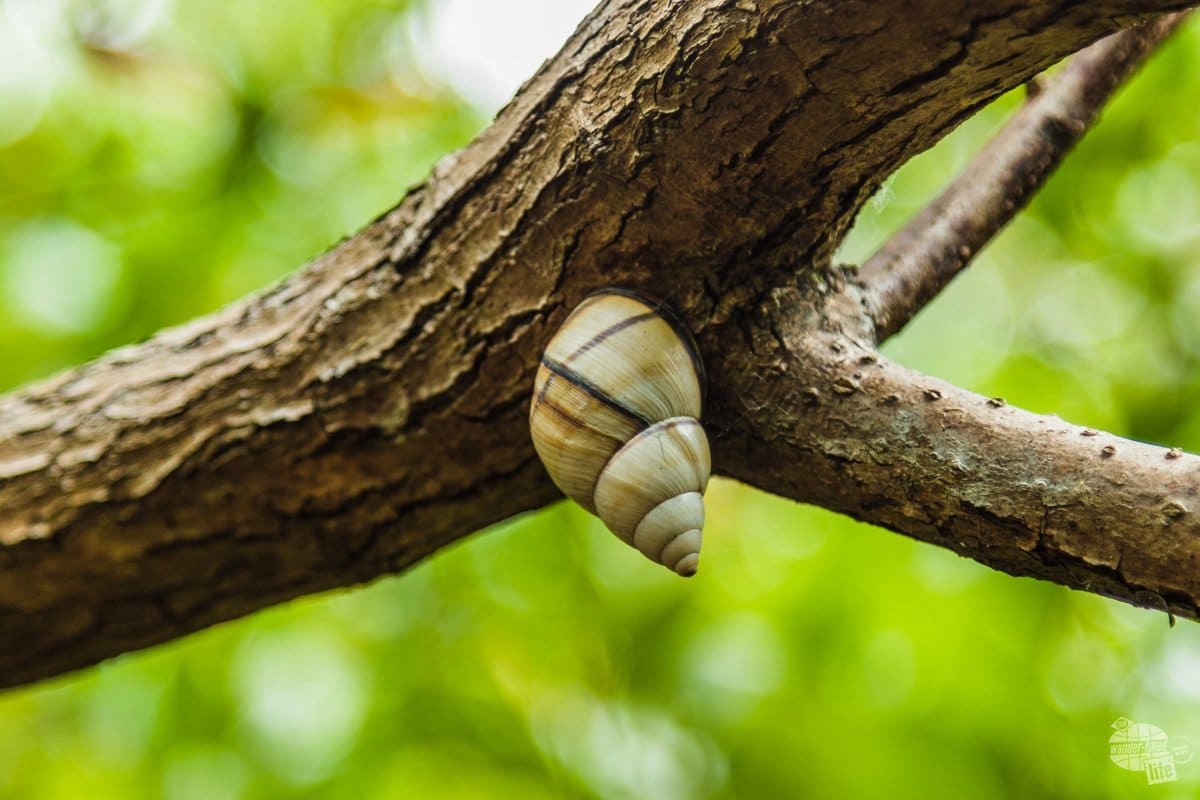
Towards the end of the drive is the Tree Snail Hammock Trail, a short easy trail through a hardwood hammock with plenty of the gorgeous snails high up in the trees.
Where to Stay and Eat for the Everglades and Big Cypress
Finding a campground during the winter is tough in South Florida. There are plenty of snowbirds and permanent residents living in most of the campgrounds so finding a spot can be tough, not to mention expensive.
We stayed at the Miami Everglades RV Resort. While our campsite was comfortable, it was right next to the park’s sewer treatment facility, which was loud and stank. On the plus side, it was centrally located, about an hour from Everglades, Biscayne National Park and Big Cypress.
Click here to read more about our visit to nearby Biscayne National Park.
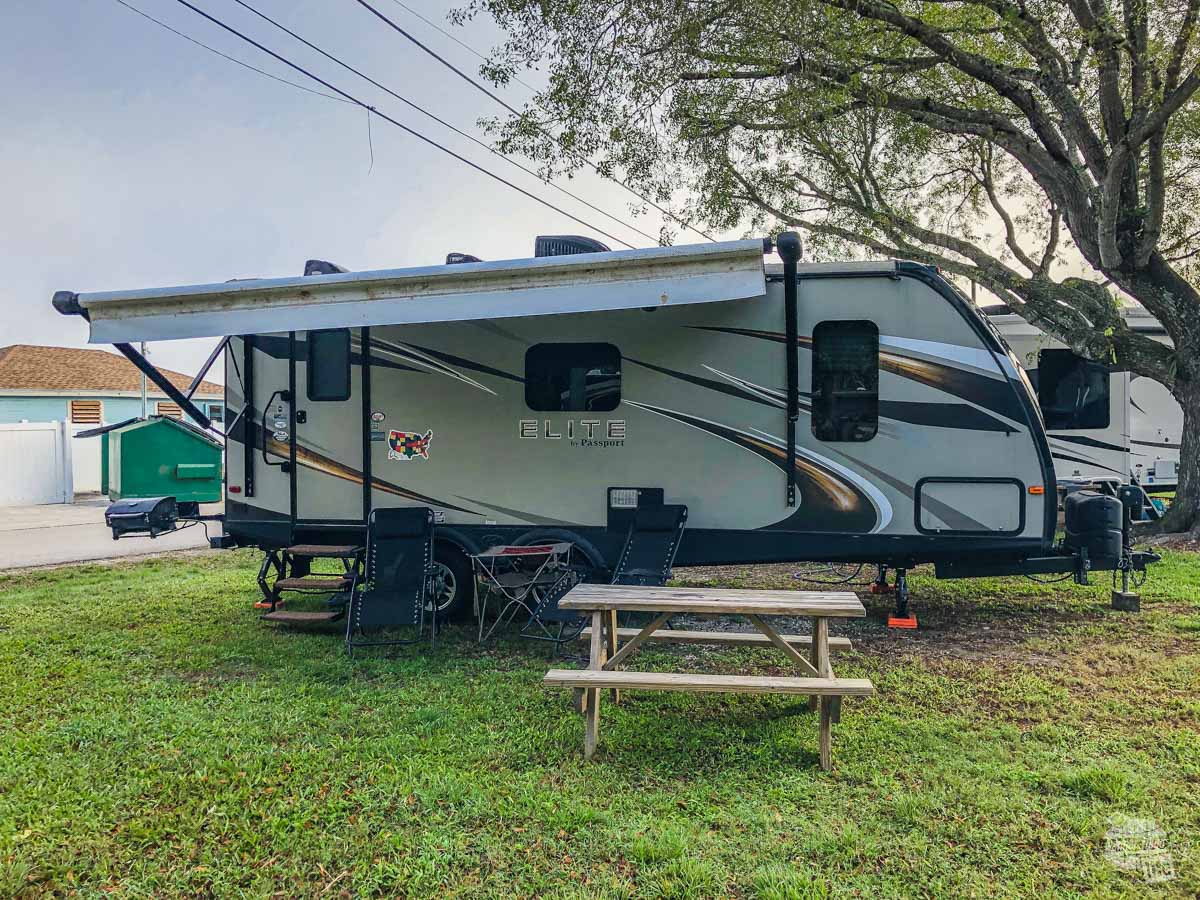
We would stay here again if we could get a site located far from the sewer treatment plant.
Read our in-depth campground reviews here.
There are plenty of hotels along US 1 further south and closer to the main park entrance for the Everglades. You can also camp in the Everglades but there are no full hook-up sites (electric only) and the aforementioned tents you can rent.
Florida is home to one of our favorite fast-casual restaurants, Pollo Tropical, and there are plenty of them in the area. The Tropichop bowls make a great meal and be sure to hit the sauce bar for some really interesting choices.
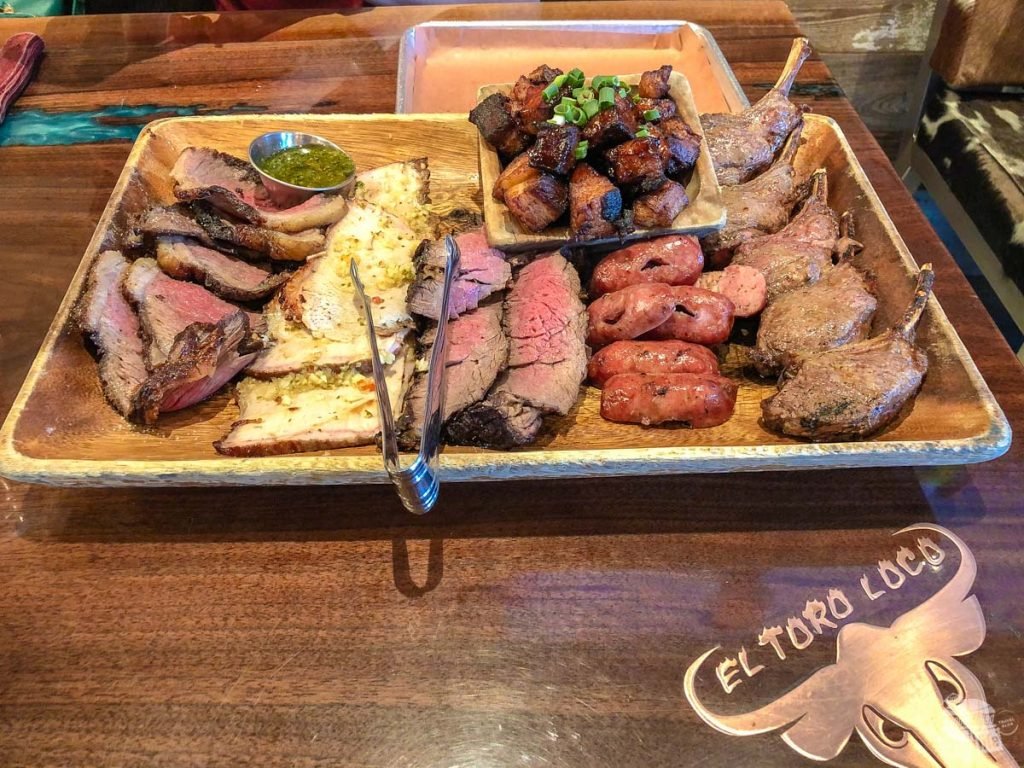
We also found El Toro Loco, a local churrascaria, which was AMAZING! We split the Picada Deluxe, which was an amazing plate of grilled meats. It easily provided two VERY full meals and we are still raving about how good it was.
Another stop you should definitely make is at the fruit stand Robert is Here. This place is on the way to the main entrance to Everglades National Park and is a South Florida institution. Started by 7-year-old Robert Moehling, this fruit stand has tons of fresh fruit plus plenty of other sauces, honey and other deliciousness.
The real treat, though, is the fresh fruit milkshakes and smoothies. I had a key lime shake and Bonnie had a strawberry key lime smoothie. Both were amazing! Oh, and we got to sing “Happy Birthday” to Robert, who was working behind the counter on his birthday.
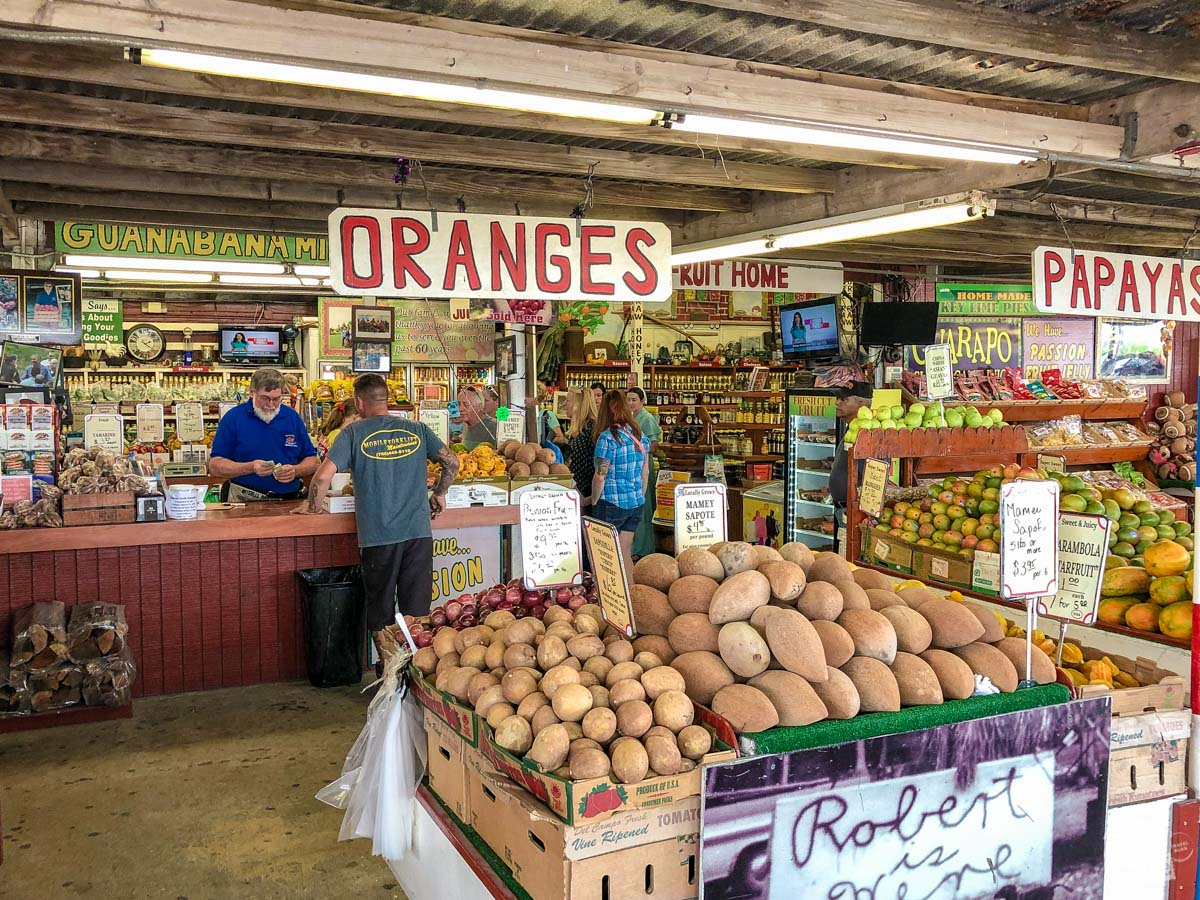
Final Thoughts on Things to Do in the Everglades and Big Cypress
This was our second visit to both of these parks and we enjoyed them so much more this time around.
The biggest difference? Getting out on the water. I know it seems obvious but getting out on the water is one of the best things to do in the Everglades. While you can see the Everglades from the trails and look down on everything from the boardwalks, getting out in a boat was truly something amazing.
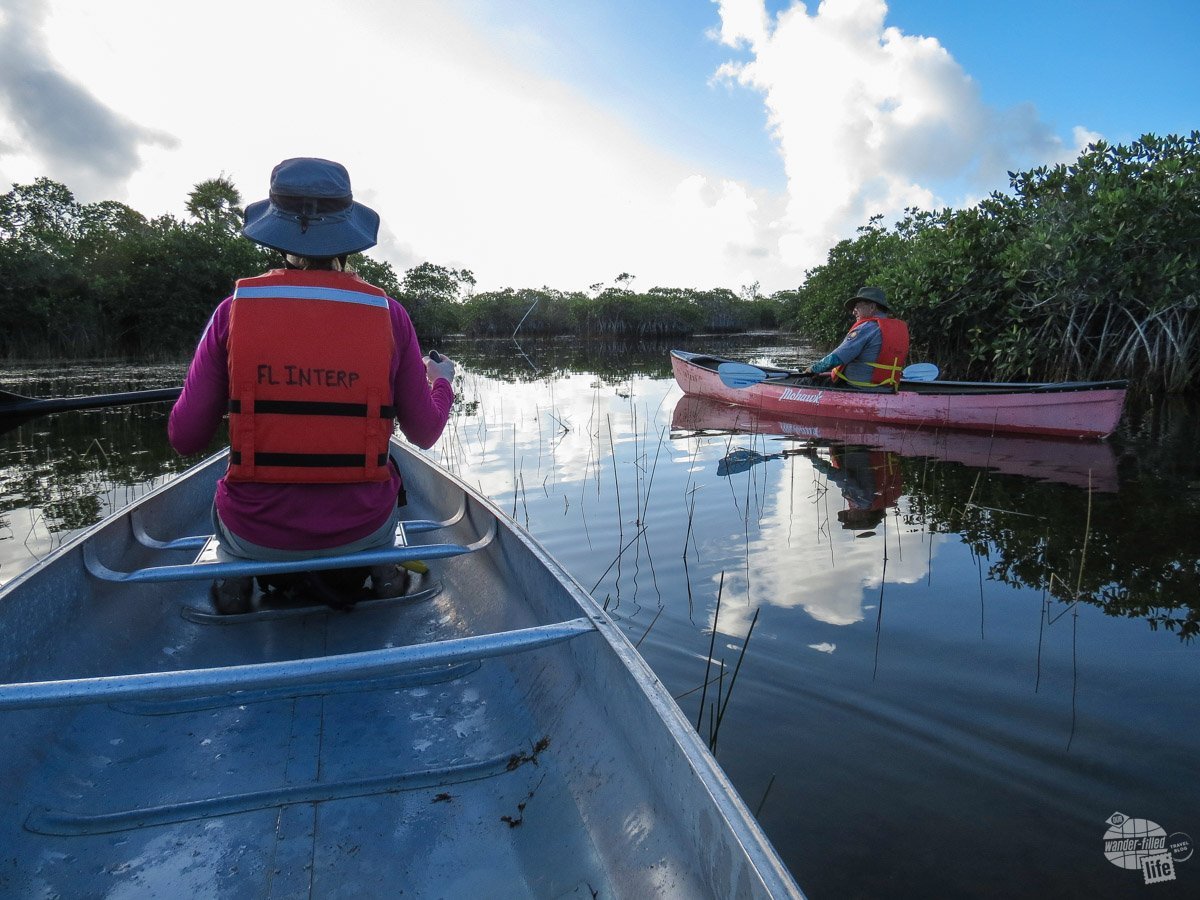
Regardless of getting in the water or not, you can easily spend three days exploring these two parks and not see everything you want. We are already thinking about what we want to do on our next trip.
That’s how cool it is.
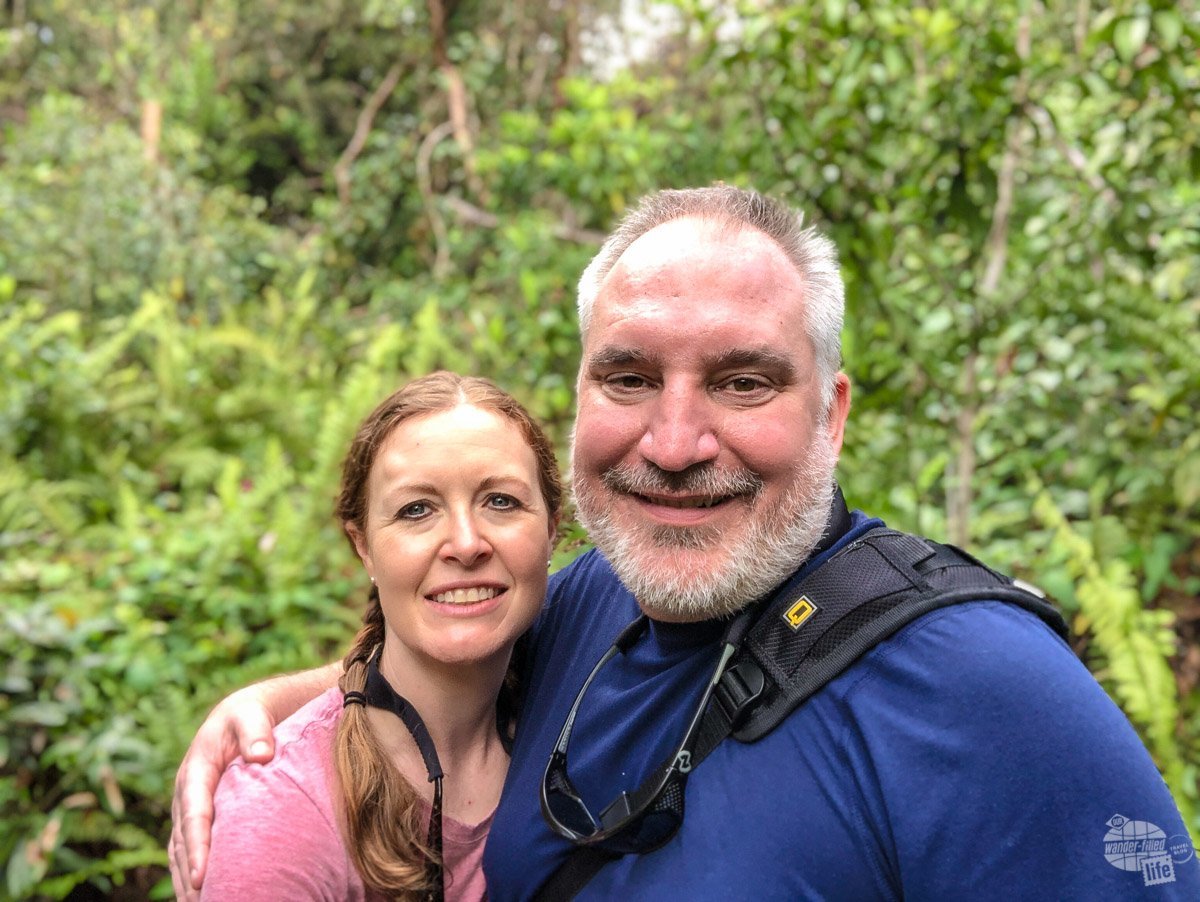
Travel Resources
What do you use to find a flight?
We use Skyscanner to find deals on flights. Skyscanner has a great interface and compares tons of airlines for the best pricing and routing. That said, it does not always have every airline and some airlines will have better deals on their website. Still, Skyscanner is a great place to start.
Click here to search for a flight.
What do you use to find a hotel?
We typically stay at Hilton properties, so we use the Hilton website. You can find good Hilton Honors discounts or AAA discounts for a hotel there. We make great use of our free night certificates from our Hilton Honors American Express.
Click here to book a Hilton property.
If there are no Hilton properties available, we use TripAdvisor to read reviews and book the hotel. We find we can get the best price that way.
Click here to search for a hotel.
We recently partnered with Stay22 to add interactive maps to each of our destination posts. This will allow you to see a plethora of hotels and vacation rentals all in one responsive map of the area.
What if I need more space than I can get at a hotel?
We use Vrbo for the times when we have rented a cabin for a weekend getaway, like this cabin in Townsend, TN, or needed to rent a house for a large family vacation. We had a great experience with them in terms of refunding deposits when COVID hit and will continue to use them.
Click here to search for a vacation rental.
Who do you use for rental cars?
As a general rule, we book with Hertz for rental cars. We have had nothing but good experiences with them. Plus, we really like unlimited mileage and not worrying about crossing state lines. We have even rented from Hertz overseas in both Slovenia and Croatia.
Click here to book a rental car.
How about booking a cruise?
We have found some amazing prices for booking a cruise through Cruise Direct. We have saved a lot of money on our cruises compared to what we found elsewhere, making a last-minute Bahamas cruise even cheaper.
Click here to book a cruise.
What if I want to rent an RV?
We highly recommend Outdoorsy for RV rentals. We rented a camper van for a week to visit Rocky Mountain National Park for the elk rut and Custer State Park for the Buffalo Round-Up and had a blast. The program was easy to use and we really enjoyed the freedom of having a camper van for that trip.
Click here to rent an RV.
What do you use for booking tours?
We don’t often book tours. Typically, we like to do stuff on our own. That said, there are some experiences you can’t have any other way. So, when we do want to book a tour, we always check Viator first.
Click here to book a tour.
Do you use anything to get discounts on the road?
We make extensive use of both Good Sam and AAA on the road. Good Sam is normally regarded as a discount card for RVers at campgrounds and Camping World but anyone can use the 5 cents off a gallon at the pump at both Pilot and Flying J.
Click here to get a Good Sam membership.
We have had AAA as long as we have been married and it has more than paid for itself in discounts at hotels, aside from the peace of mind of having roadside assistance. Add in paper maps and the ability to get an international driver’s license and it is more than worth it for any traveler out there.
Click here to get a AAA membership.
Pin It!
